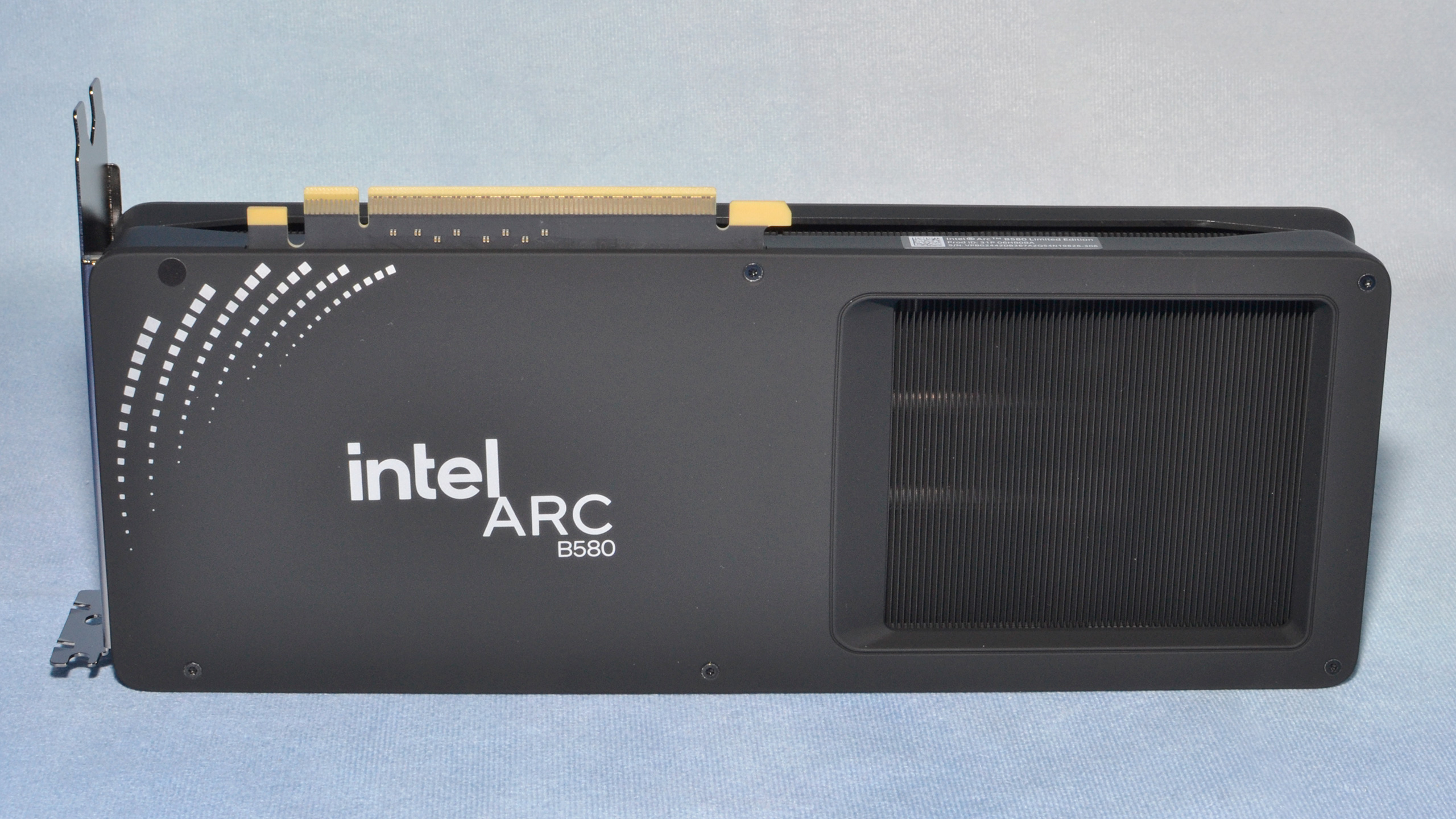Why you can trust Tom's Hardware
Intel has put more effort into its ray tracing hardware than AMD, at least for similarly priced GPUs. The A-series tended to match Nvidia's mainstream RTX 3060 in RT performance, perhaps even beating it slightly depending on the game. The B580 aims to take down the RTX 4060 in a similar fashion, unlike AMD's RX 7600 that falls well behind in RT performance.
After years of hearing about ray tracing from Nvidia, our opinion of the technology has been dampened quite a bit. There are some games that put the tech to good use, like Control, but there are also a lot of other RT-enabled games where the performance hit doesn't justify the minor visual upgrade. That often goes double for full RT modes, which are impressive as a technical achievement but basically require upscaling and frame generation on Nvidia RTX 40-series hardware to reach decent levels of performance.
Except, now Arc Battlemage might offer some needed competition. Maybe. We're only looking at six ray tracing games for now, and we didn't enable full RT (aka 'path tracing') on any of the newer games. Minecraft does use full RT, but it's also very simple graphically compared to stuff like Cyberpunk 2077 and Alan Wake 2. But if you'd like us to include more full RT games — the list has grown recently, with additions like Black Myth Wukong, Indiana Jones and the Great Circle, and a few others — let us know.
We still feel most full RT games inherently end up being heavily optimized for Nvidia GPUs, because Nvidia has been pushing the tech far more than AMD or Intel, so even if we do include some full RT tests we probably won't factor those into the geomean scores, unless we start seeing enough of a visual quality uplift to make it worth reconsidering. But let's look at the RT benchmarks.
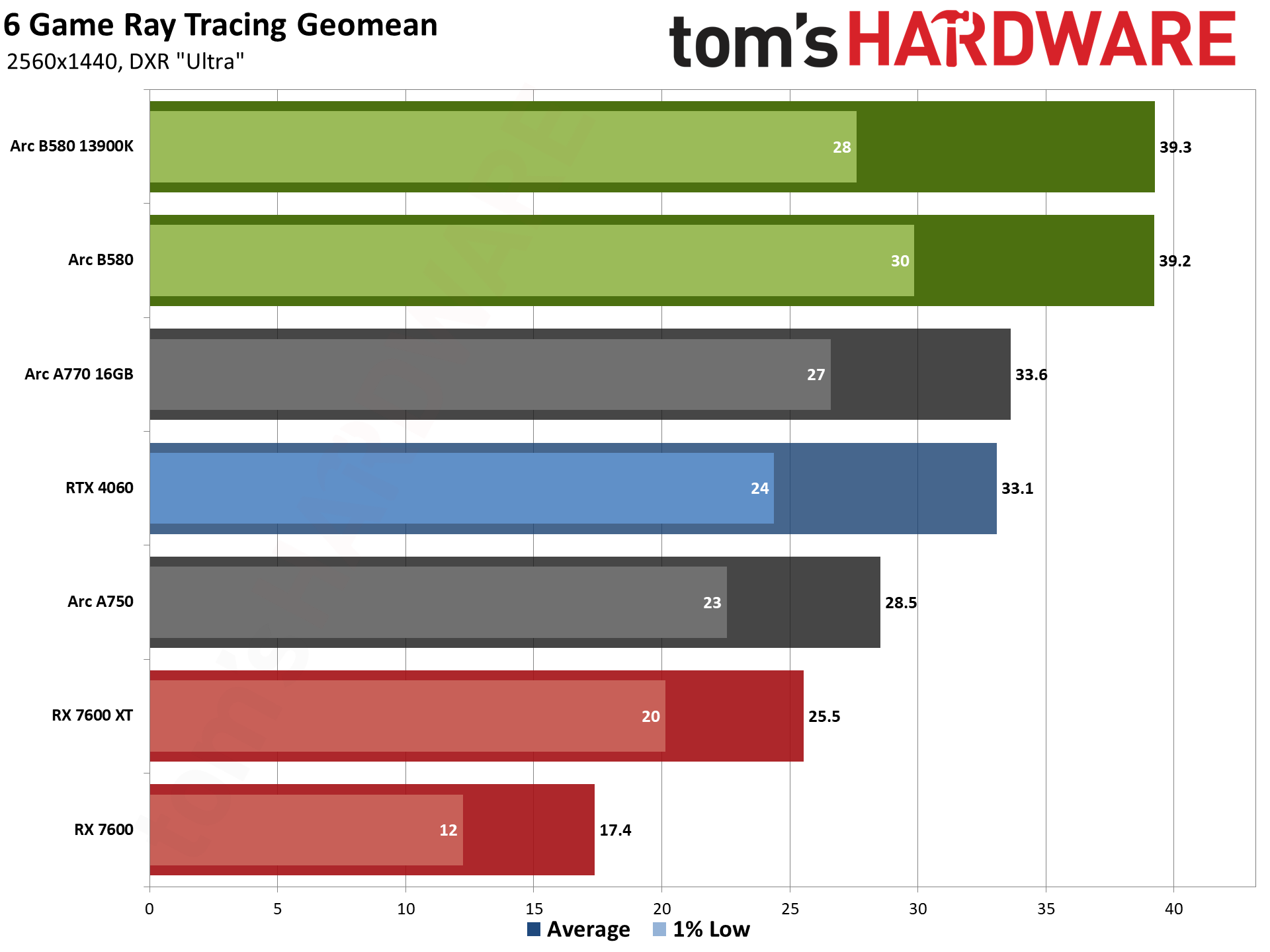
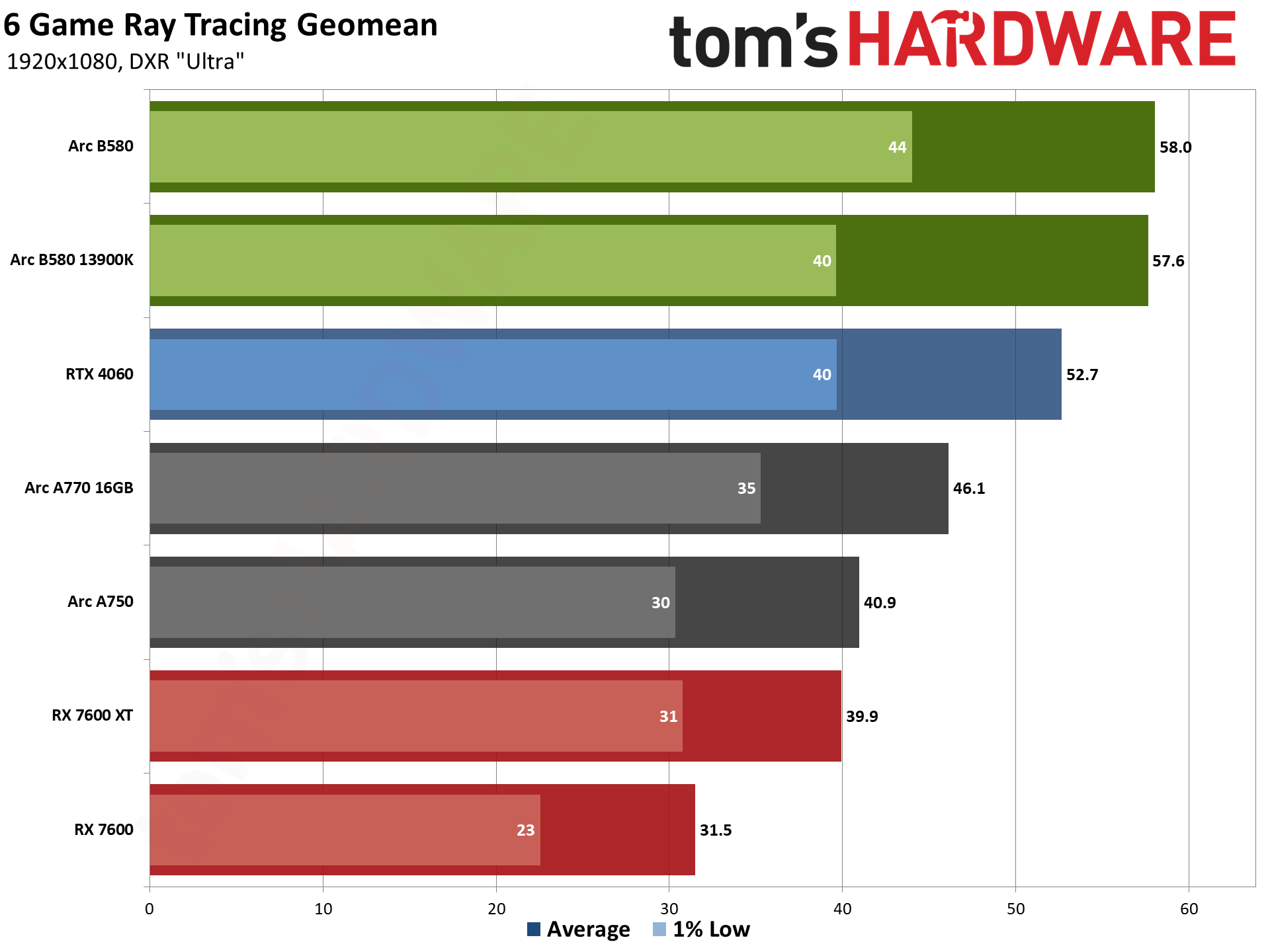
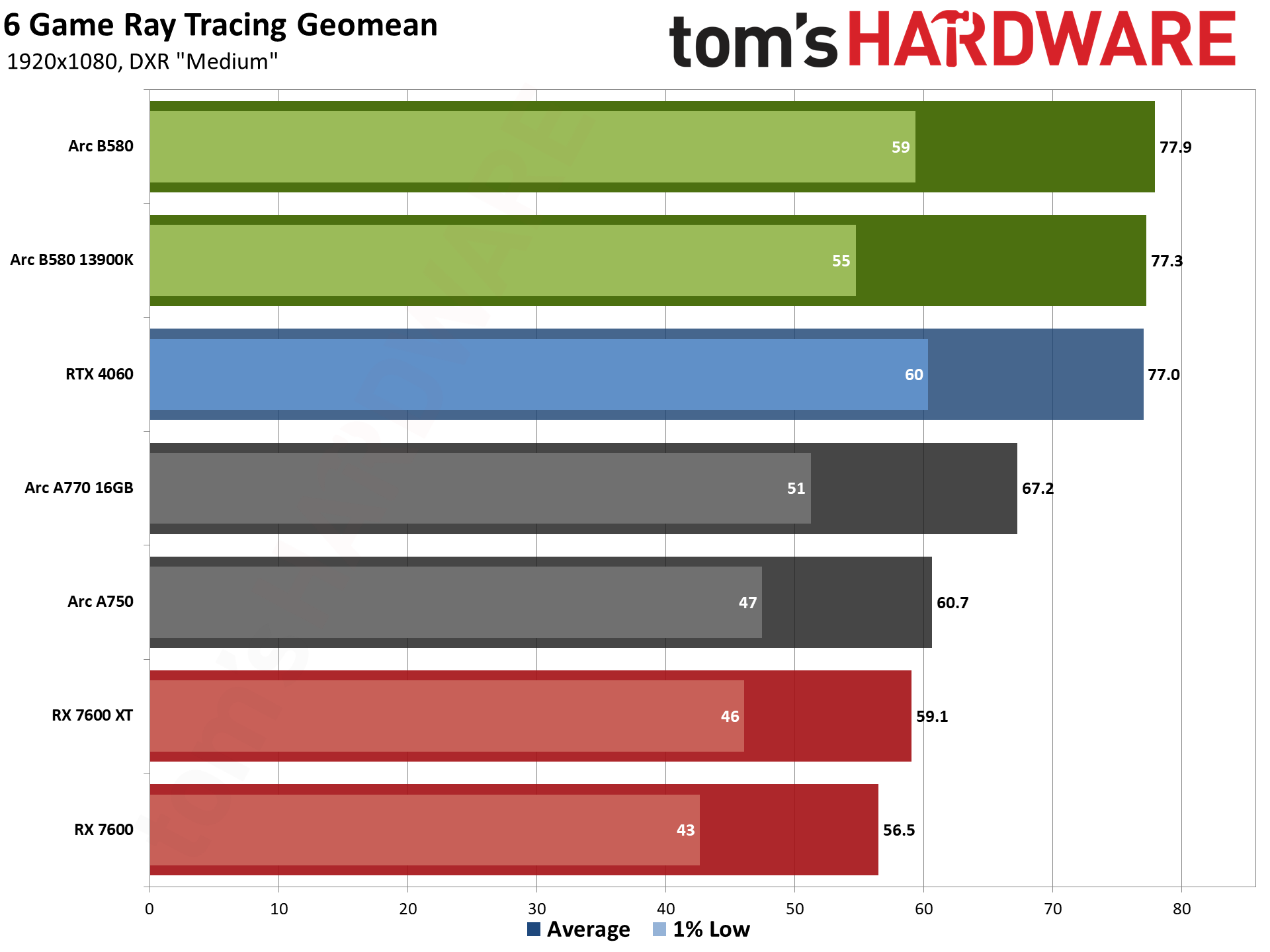
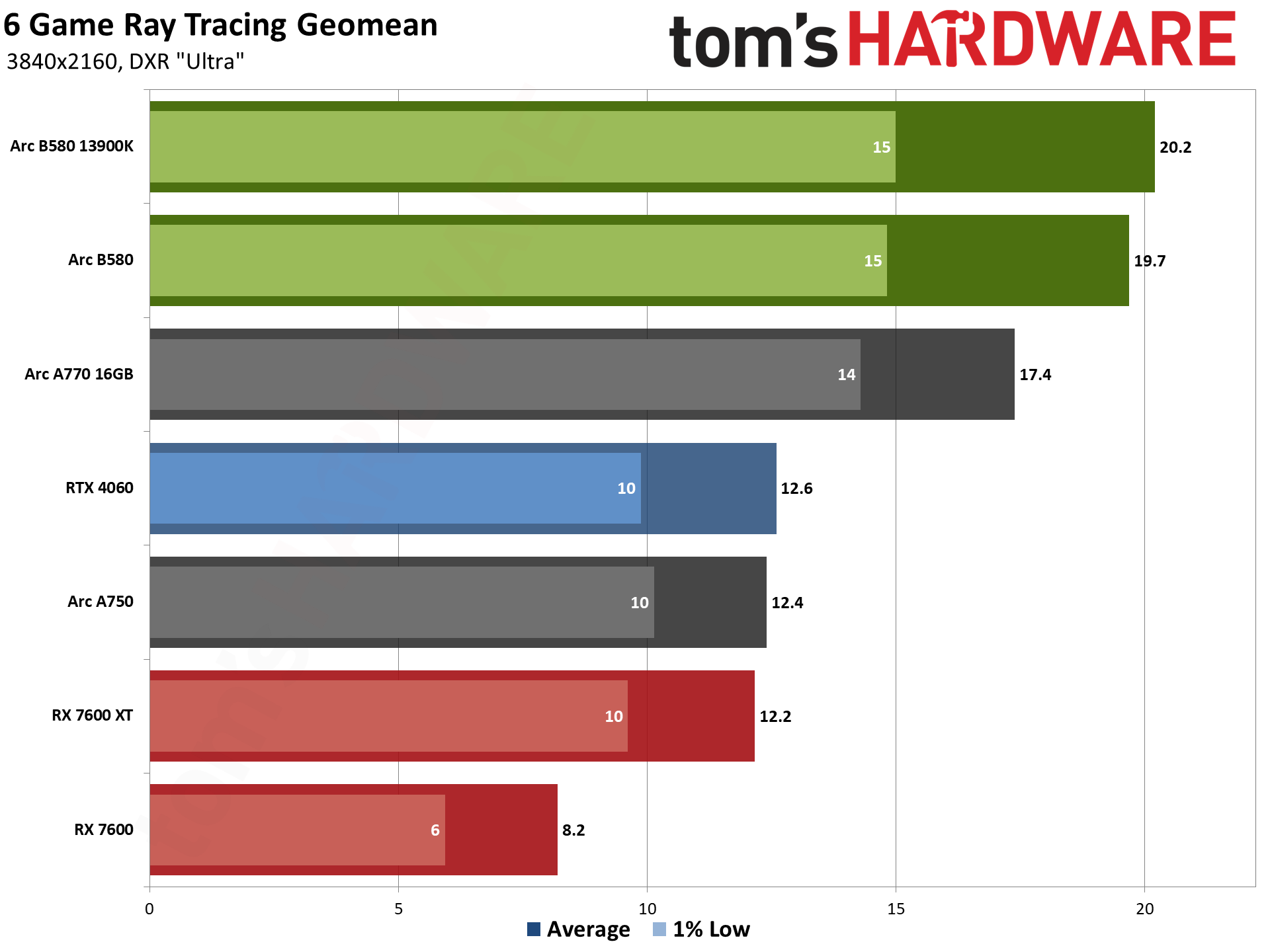
Our geomean for ray tracing looks very different from the rasterization numbers. Where AMD's RX 7600 and 7600 XT could be quite competitive in rasterization games, they fall well behind on ray tracing performance. The 8GB card in particular struggles badly. Nvidia's lowest tier desktop RTX 4060 card doesn't exactly excel, hobbled by the 8GB VRAM as well, but it easily pulls ahead of AMD's offerings.
Intel's Arc B580 matches the RTX 4060 at worst (for 1080p medium), and starts pulling away at higher quality settings and resolutions. Even the Arc A770 manages to surpass the 4060 at 1440p ultra, mostly due to the lack of VRAM on Nvidia's GPU. And of course you're probably not planning on running maxed out 4K at native resolution on a $250 GPU, so that's mostly just there for reference.
Keep in mind that the lower resolution numbers are also useful as proxy upscaling results, as 4K with performance mode upscaling renders at 1080p, while 4K with quality mode upscaling renders at 1440p. There's still overhead with the upscaling process, but if 1080p native is playable, that means you can typically stretch that to 4K via upscaling if you want.
Overall, in our ray tracing test suite, the Arc B580 claims top honors. At 1080p medium, 1080p ultra, 1440p ultra, and 4K ultra (in that order for each GPU), it's:
- 1%, 10%, 19%, and 56% faster than the RTX 4060
- 16%, 26%, 17%, and 13% faster than Arc A770 16GB
- 29%, 42%, 38%, and 59% faster than Arc A750
- 32%, 45%, 54%, and 62% faster than RX 7600 XT
- 38%, 84%, 126%, and 140% faster than RX 7600
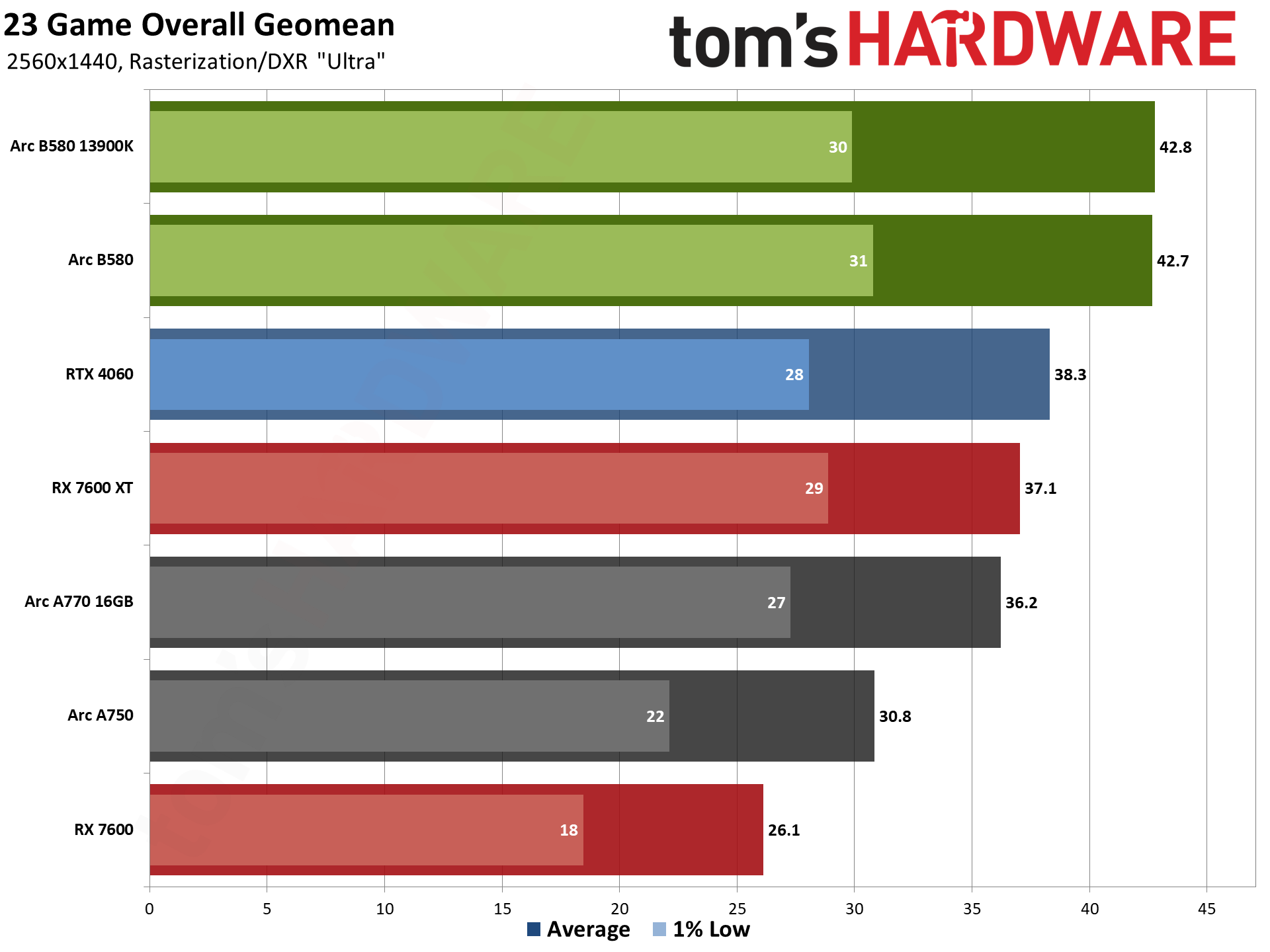
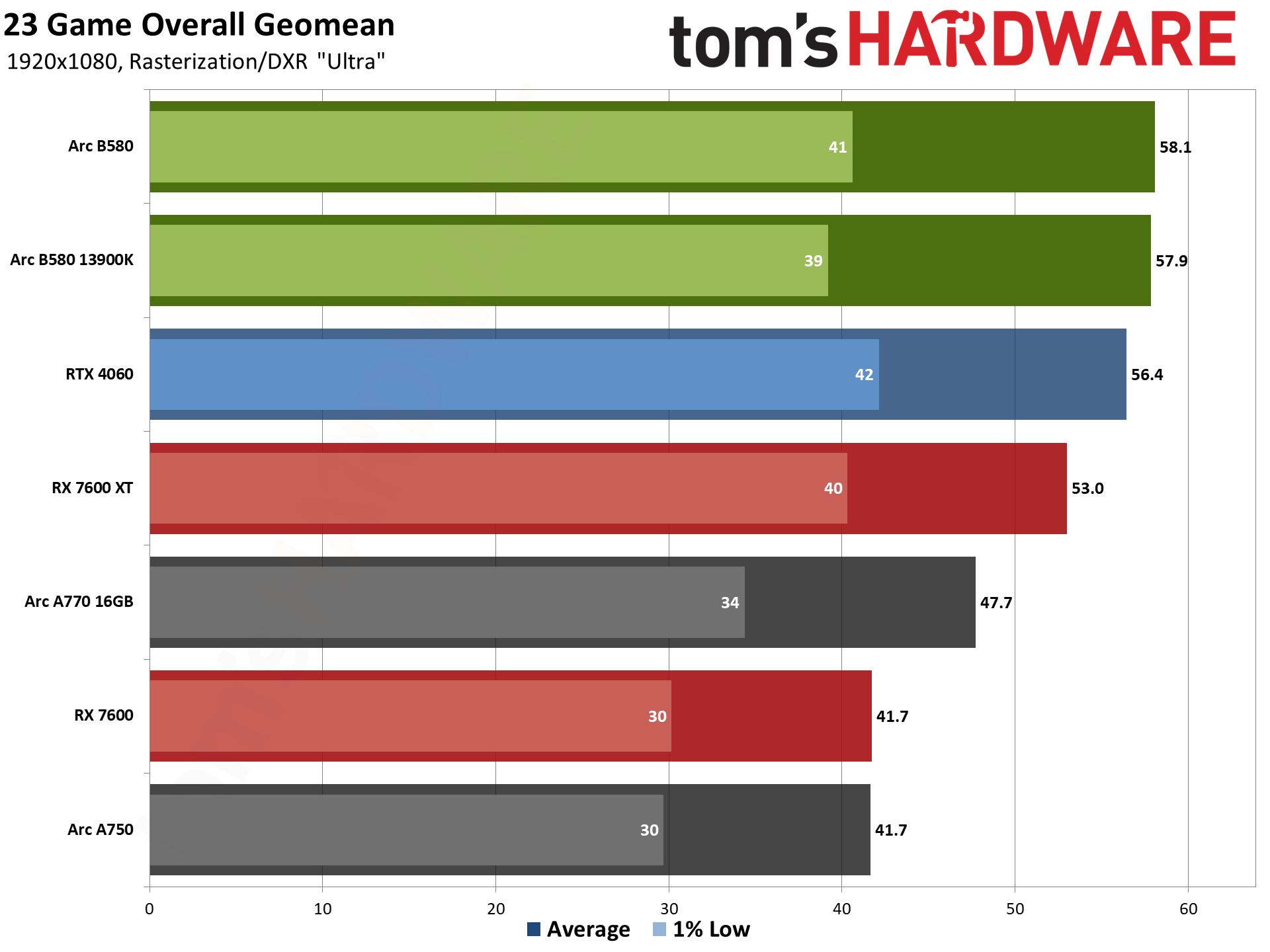
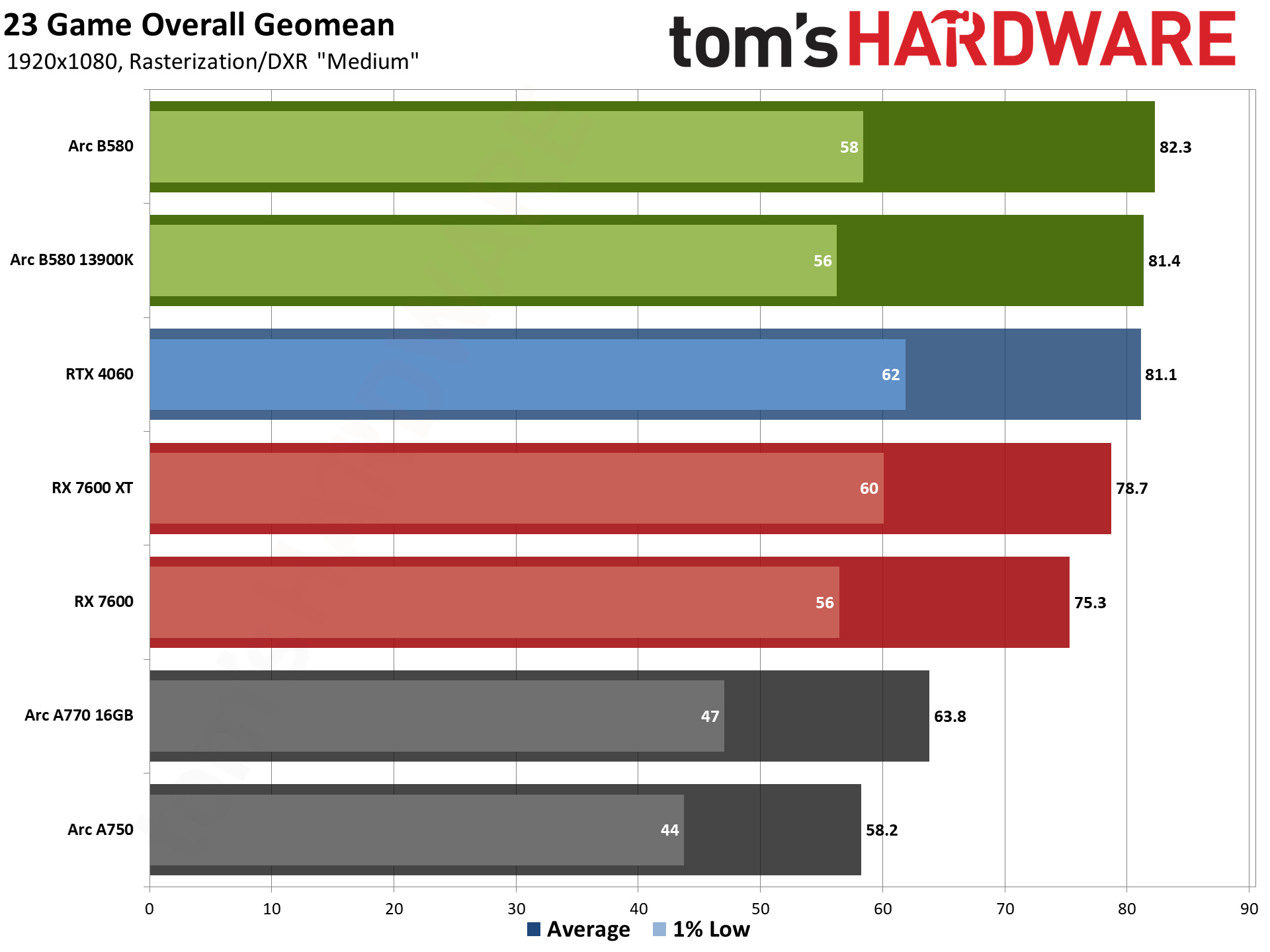
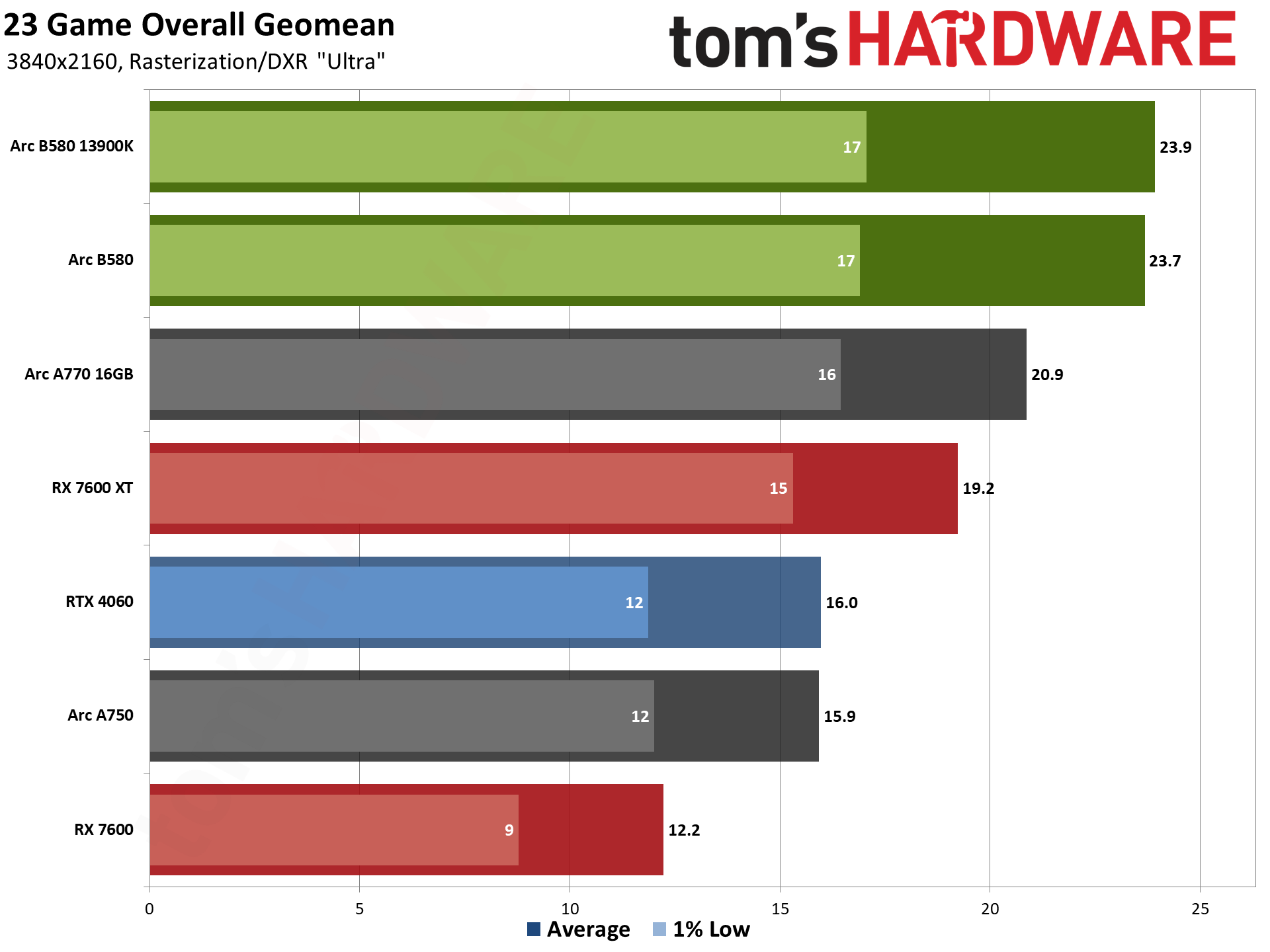
And now that we have all the rasterization and ray tracing results, here's a look at the big picture. These charts use the geomean of all 23 games that we've tested, with RT basically accounting for a quarter of the overall score.
We think it's fair to say that there are a lot of RT games where the tech doesn't really do much other than tank performance, but there are also a select few games that definitely benefit visually from RT. So, we have far more rasterization games in our suite but still include a handful of RT games to give a more balanced overall view of how the GPUs stack up.
In the overall standings, Arc B580 ends up (again, 1080p medium, 1080p ultra, 1440p ultra, and 4K ultra in order):
- 2%, 3%, 11%, and 48% faster than RTX 4060
- 5%, 10%, 15%, and 23% faster than RX 7600 XT
- 29%, 22%, 18%, and 14% faster than Arc A770 16GB
- 41%, 39%, 39%, and 49% faster than Arc A750
- 9%, 39%, 63%, and 94% faster than RX 7600
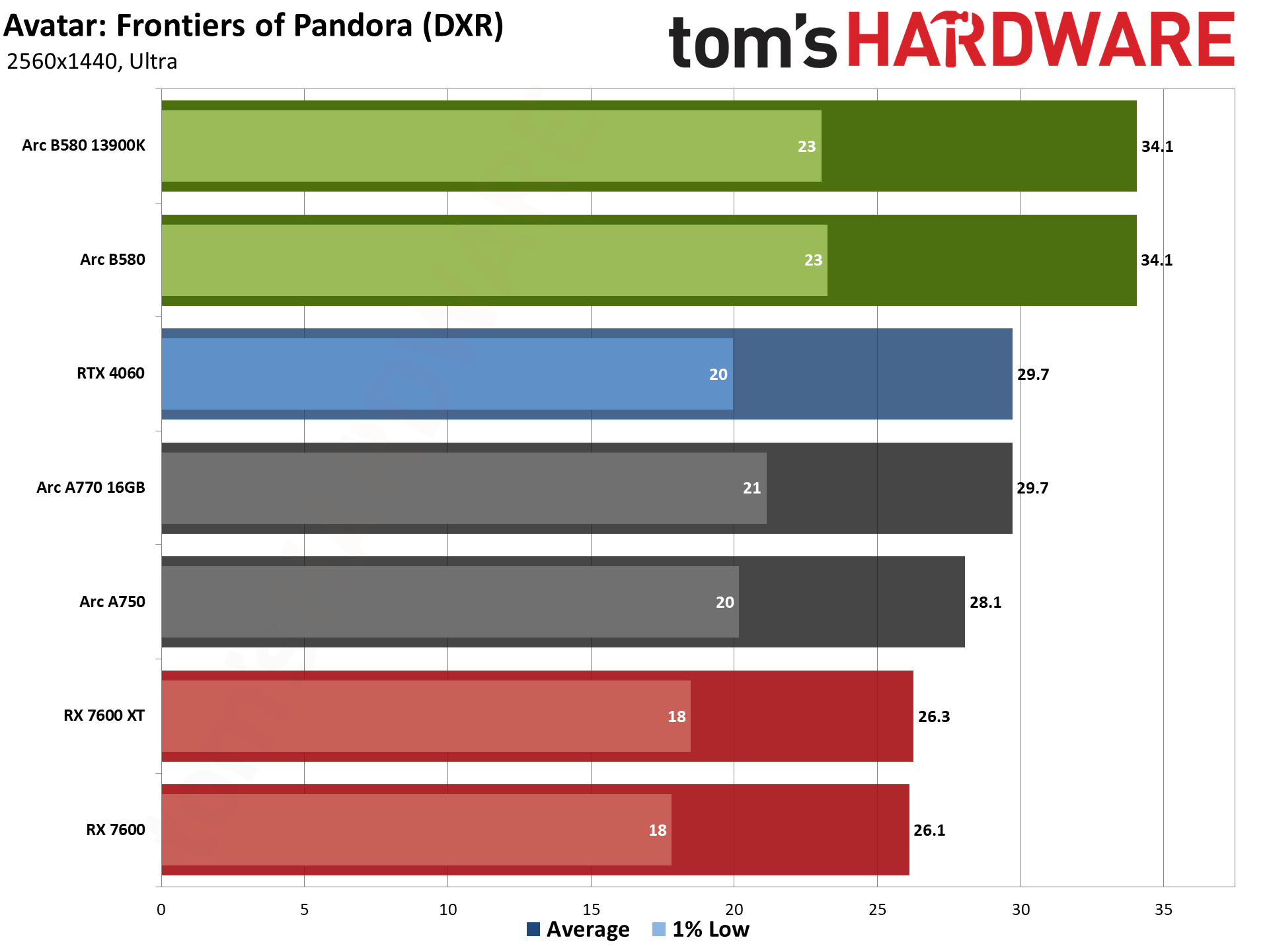
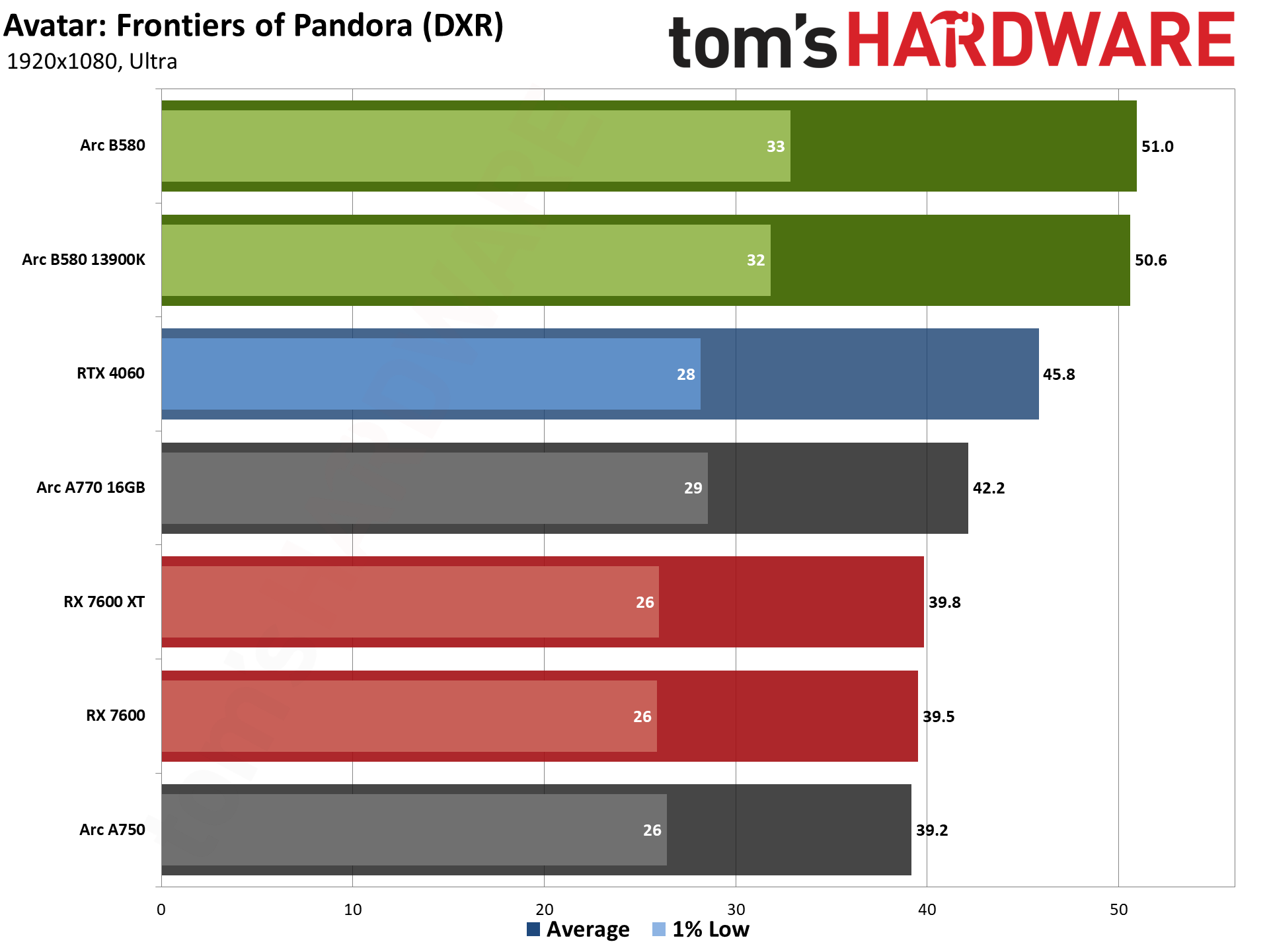
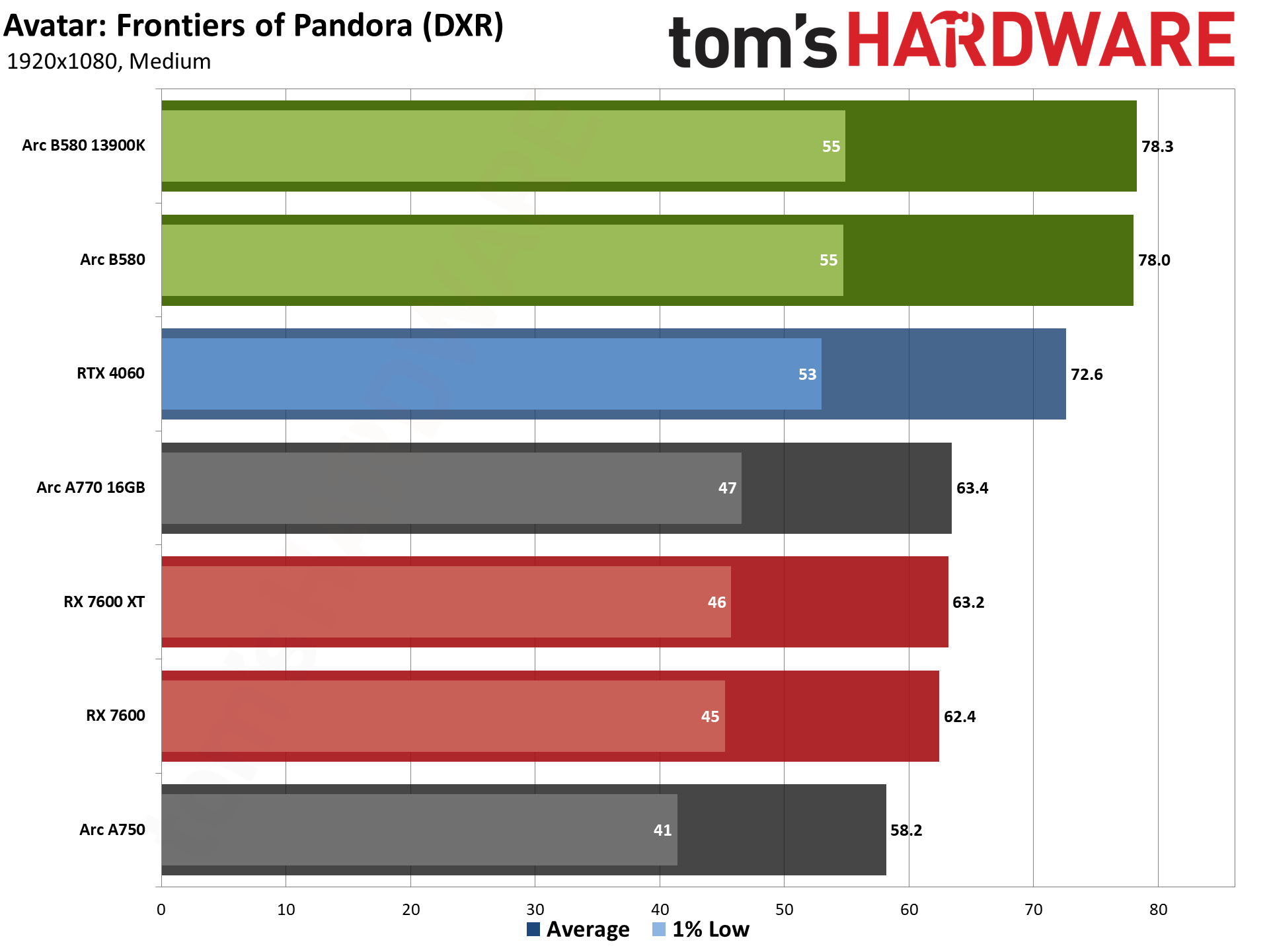
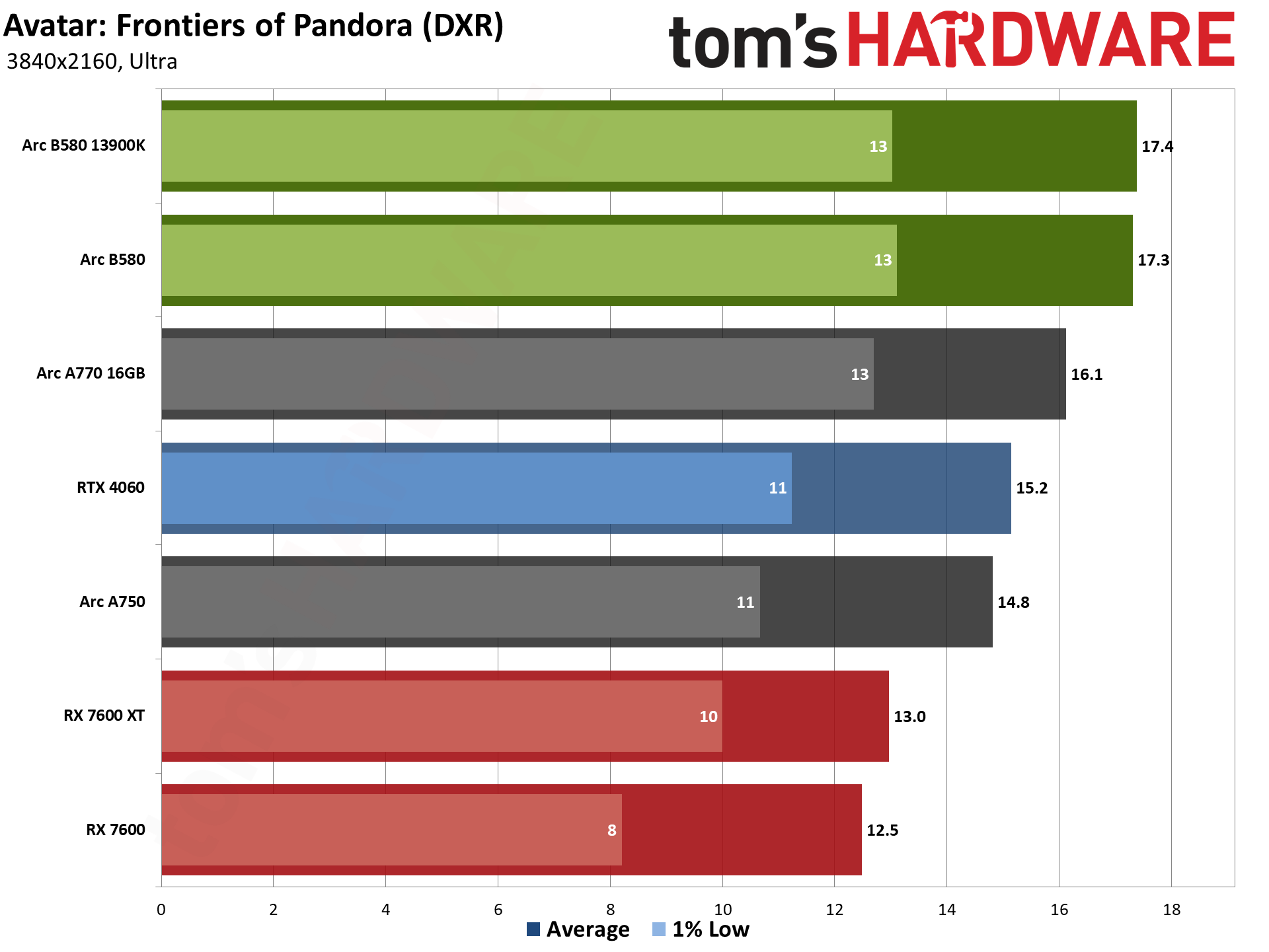
Avatar: Frontiers of Pandora uses ray tracing, but it's not particularly forthcoming on when and where it's used. Reflections in general don't appear to use RT, which is one of the most noticeable upgrades RT can provide. Instead, it's used for shadows and possibly global illumination and some other effects. What I can say for sure is that nothing in the menus (other than "BVH Quality") directly mentions ray tracing, and the performance hit doesn't seem to be as severe as in some games. Still, since there's supposed to be RT of some form, this one gets lumped into our DXR suite.
As an AMD-promoted game, you might expect the Radeon GPUs to do better. They don't. B580 beats the vanilla 7600 by 25–39 percent, and the RX 7600 XT by 24–34 percent — and there's little advantage from the additional VRAM in this particular game based on our testing. RTX 4060 does better than AMD, but the B580 still leads by 8–15 percent.
Generationally, B580 shows some decent gains as well. It's 17–34 percent faster than the A750 and 7–23 percent faster than the A770. Memory bandwidth is perhaps the biggest limiting factor at 4K ultra, as the previous generation A-series GPUs close the gap with the B580 there.
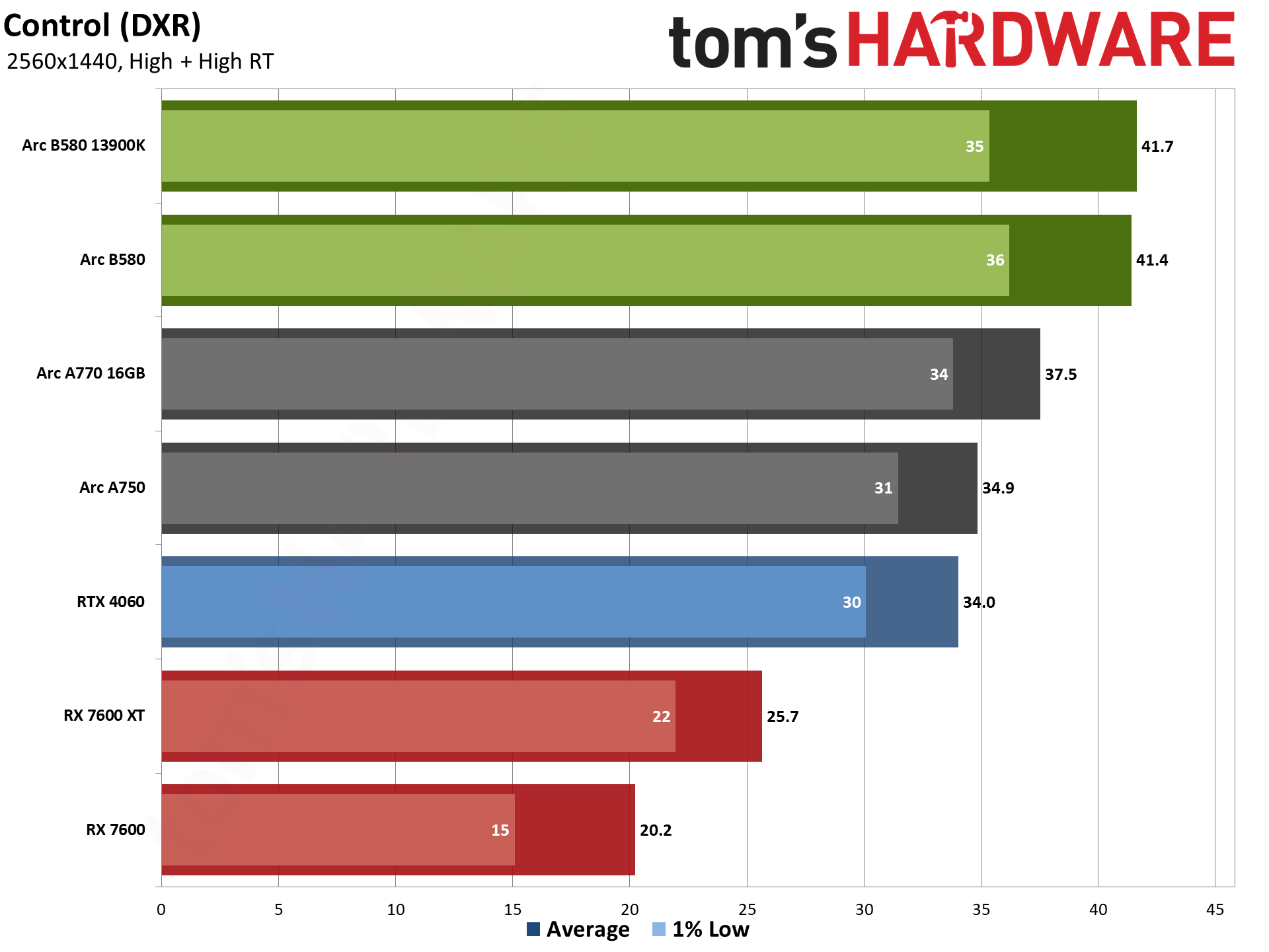
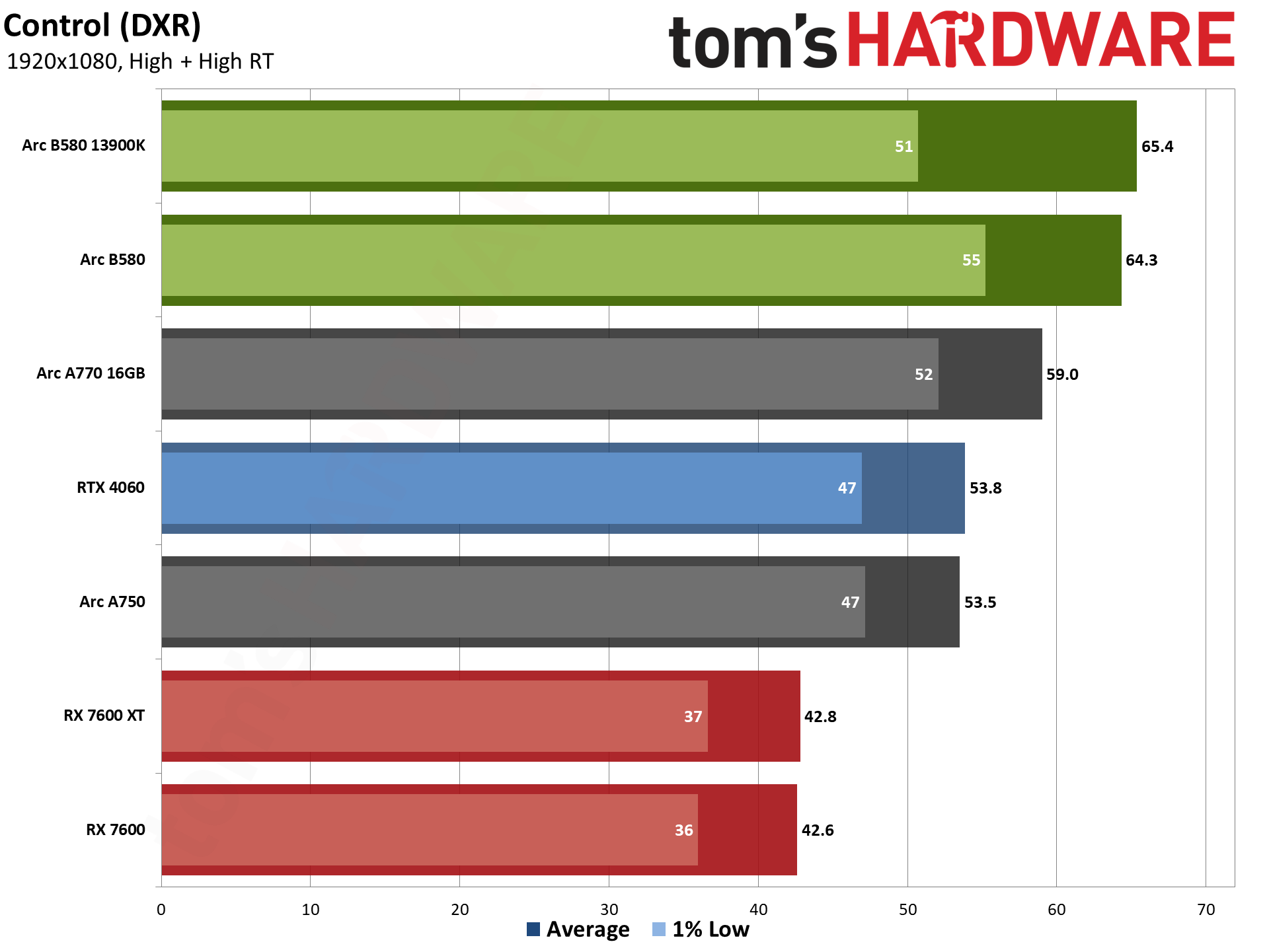
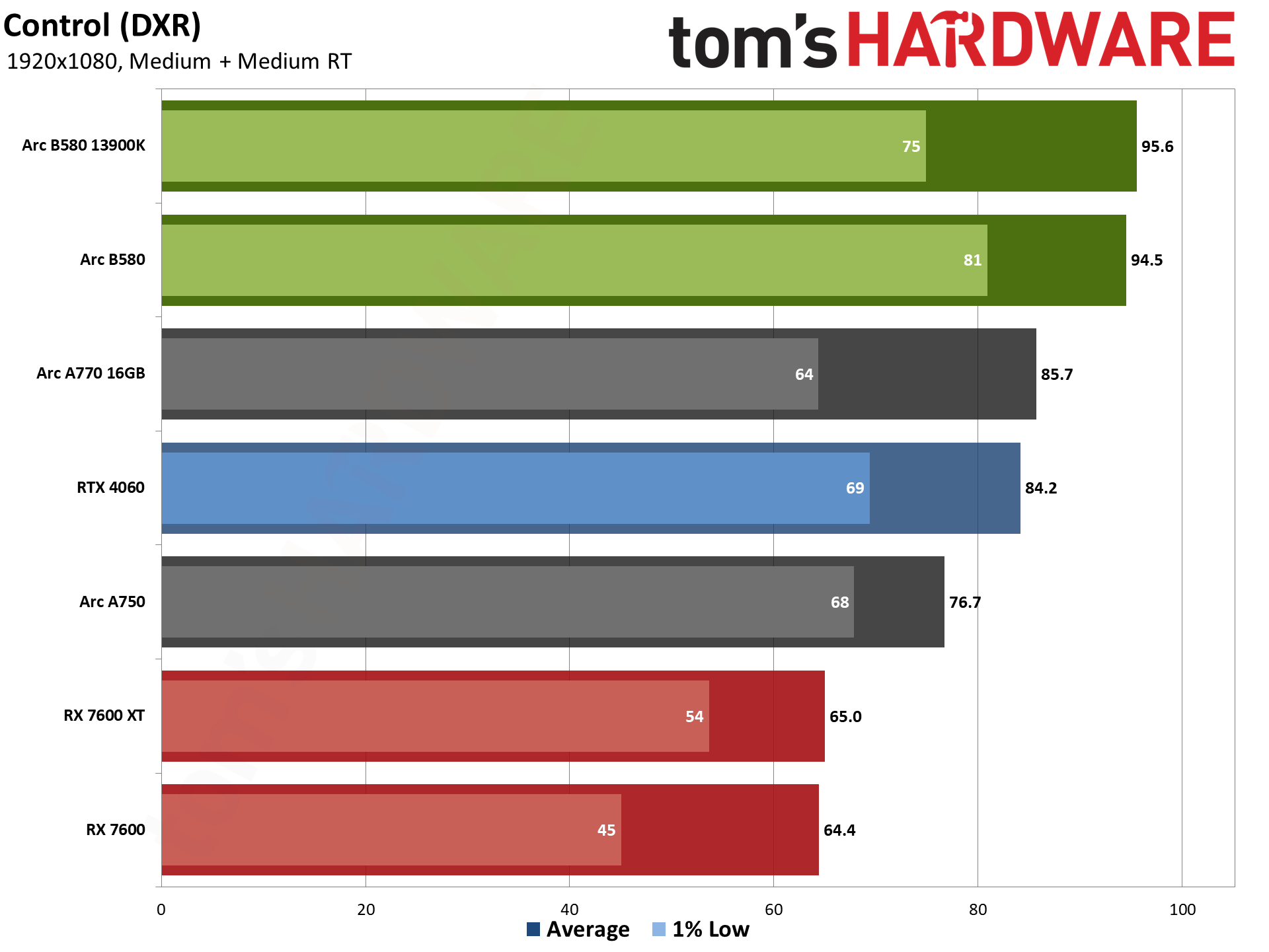
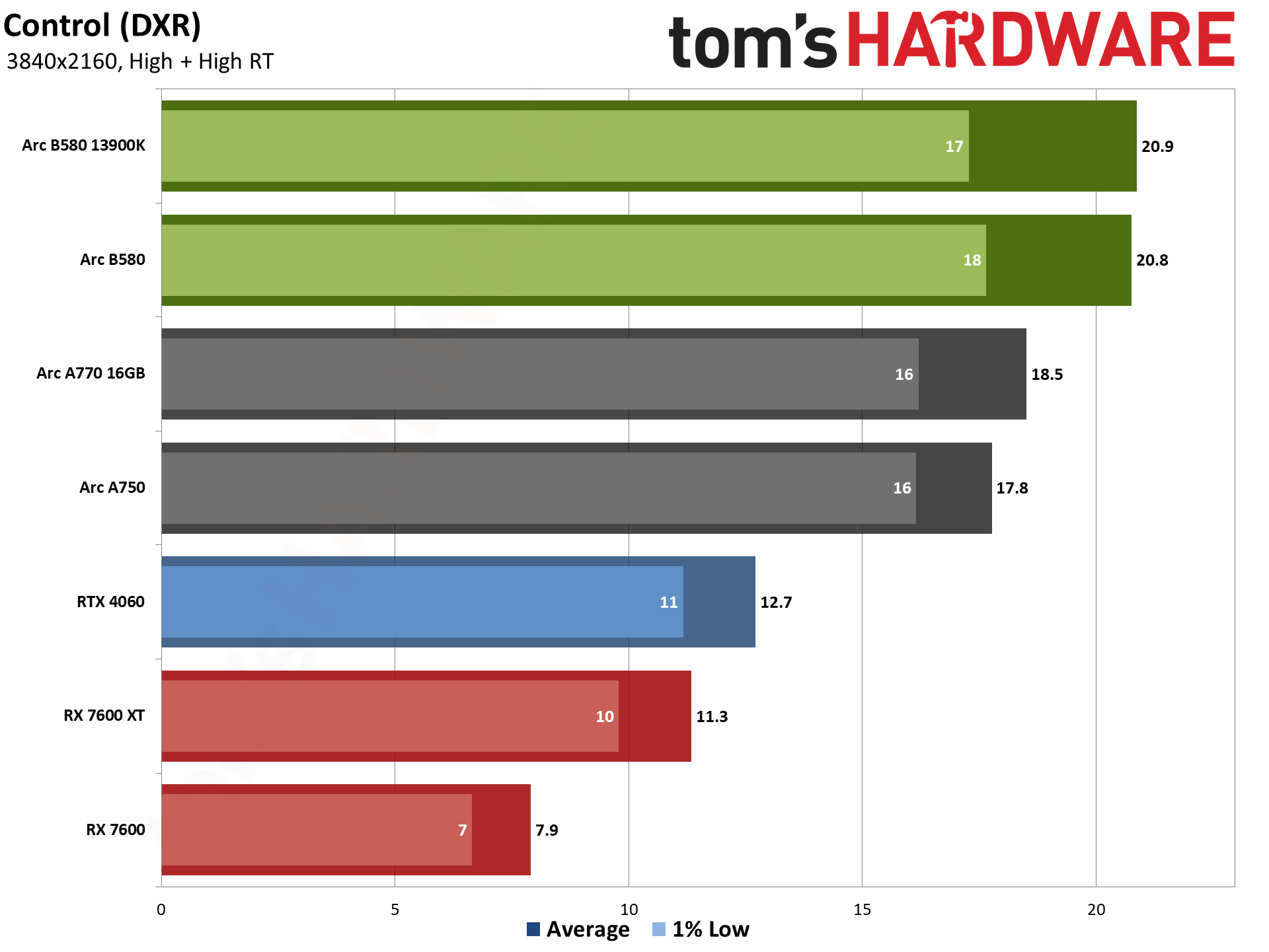
If you want a game where ray tracing is both clearly visible and actually makes the game look better, without totally destroying performance, look no further than Control. It's now five years old, and we're using the Ultimate version, but it's still arguably the best example of using RT well. And probably a lot of that is because you're running around the Federal Bureau of Control, an office space of sorts that has good reasons to have plenty of glass windows that reflect the scenery.
Control starts running into VRAM capacity issues at 1440p and 4K native, and it only supports DLSS so there's no upscaling for AMD and Intel GPUs. The B580 leads the 7600 by 47–51 percent at 1080p, but that jumps to 105% at 1440p and 163% at 4K. The 7600 XT, with 16GB of VRAM, shows a more consistent 45–61 percent lead for the B580, and 83% at 4K. You might expect Nvidia to do better, and it does, but the B580 still beats the RTX 4060 by 12–22 percent at 1440p and below, with a 63% lead at 4K.
Gen on gen, B580 ends up 17–23 percent faster than the A750, and 9–12 percent faster than the A770. This might be another game where memory bandwidth matter more than raw capacity, at least on the Arc GPUs.
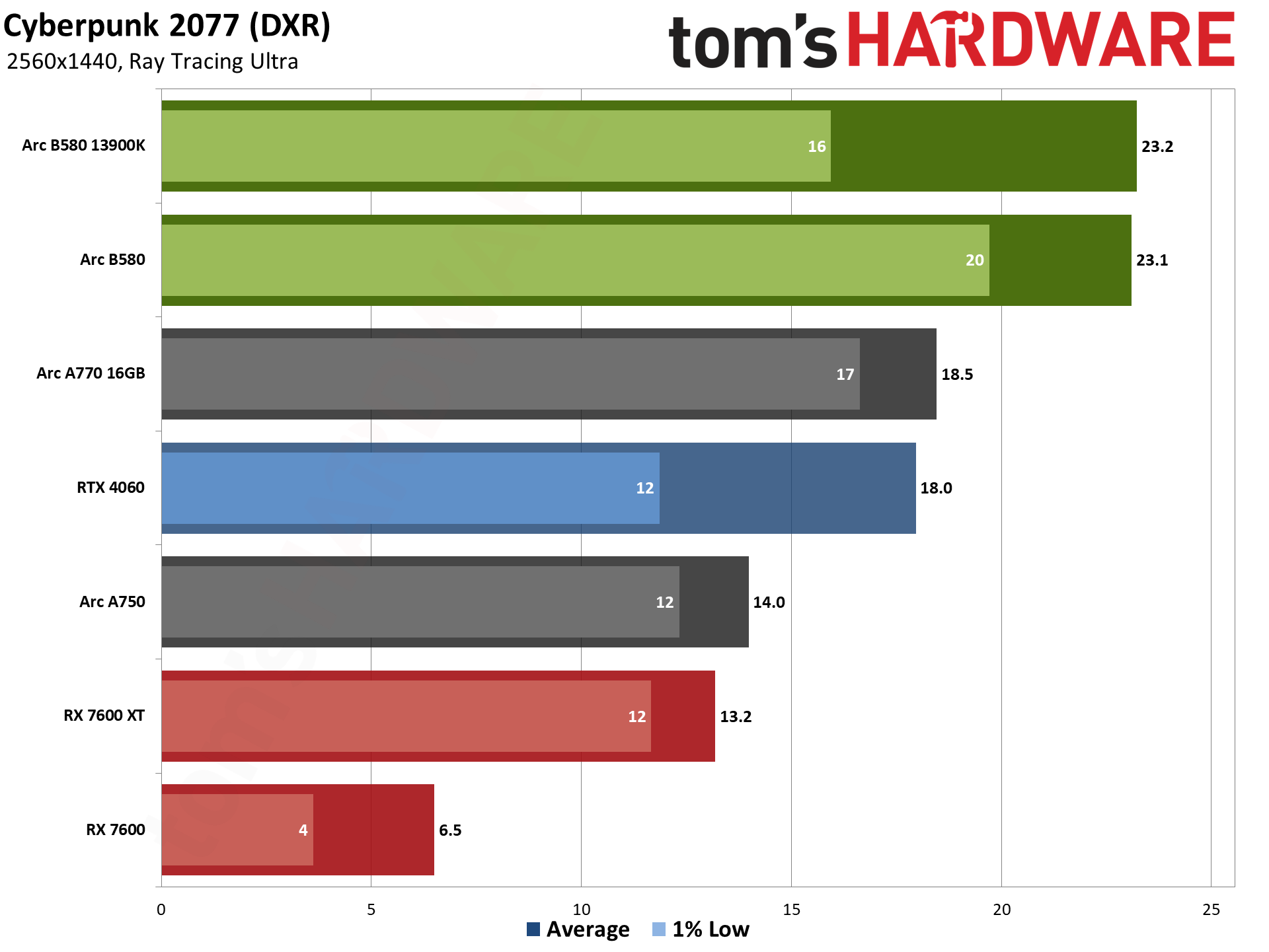
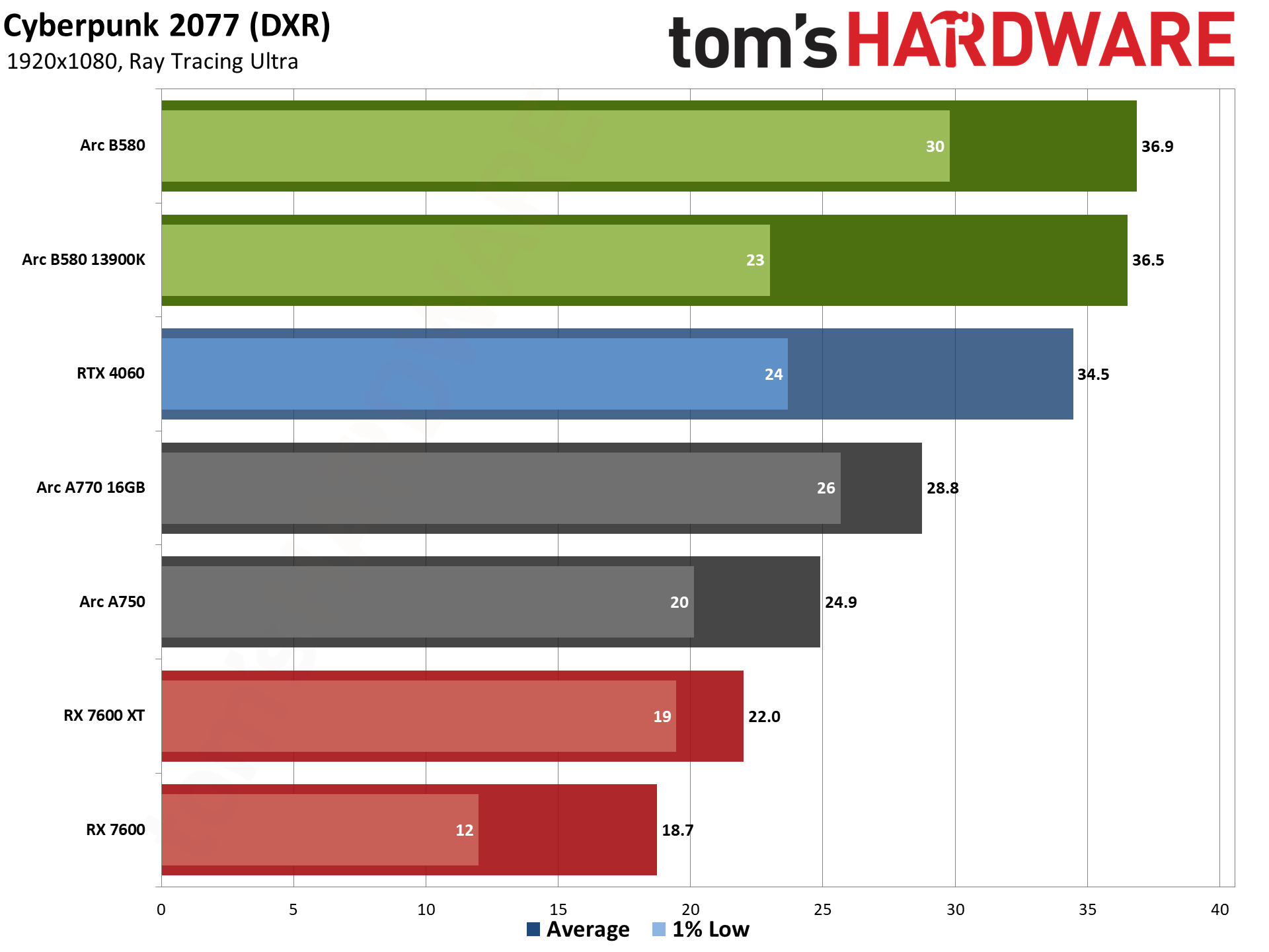
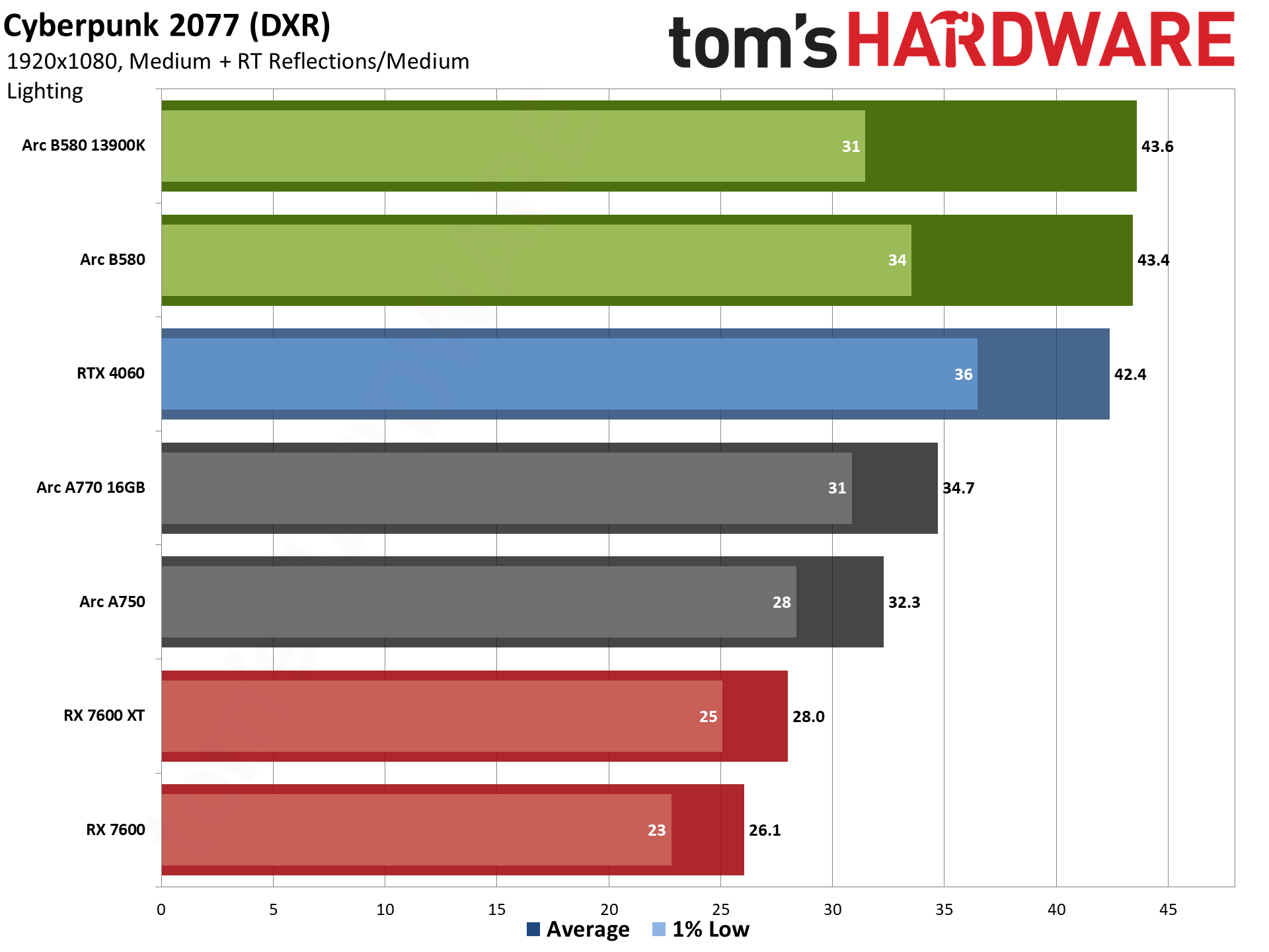
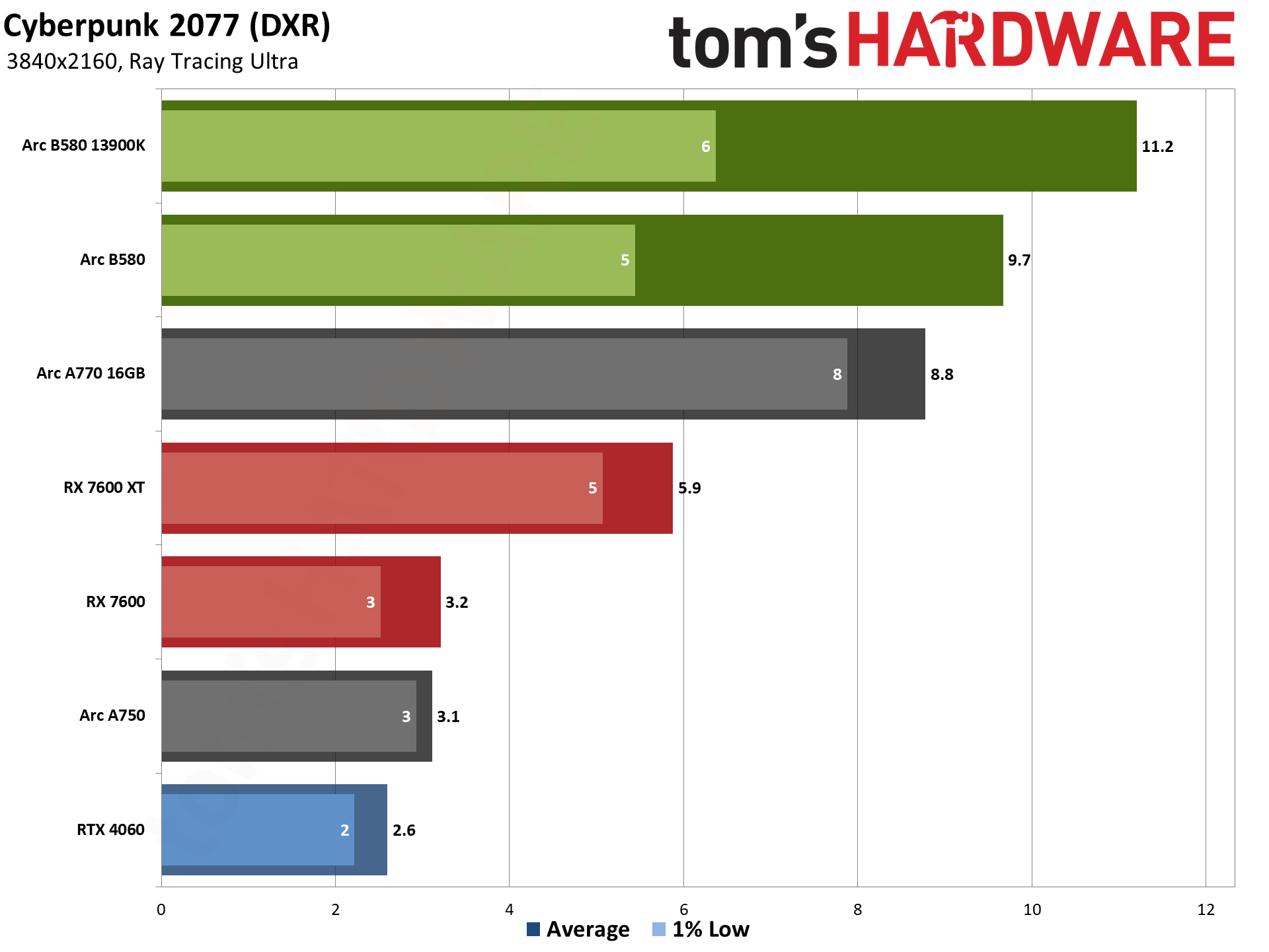
Possibly the most hyped up use of RT in a game, Cyberpunk 2077 launched with more RT effects than other games of its era, and later the 2.0 version added full path tracing and DLSS 3.5 ray reconstruction. Ray reconstruction ends up looking the best but only works on Nvidia GPUs, so as with upscaling it can be a case of trying to compare apples and oranges.
We're using medium settings with RT lighting at medium and RT reflections enabled, and then the step up uses the RT-Ultra preset. In all cases, any form of upscaling or frame generation gets turned off.
AMD's GPUs struggle badly in Cyberpunk 2077, going from bad to worse as we increase the settings. The B580 beats the 7600 by 67, 97, 256, and 201 percent. The 7600 XT doesn't run out of VRAM, so the margins are 'only' 55, 68, 75, and 65 percent.
Against Nvidia's normally superior RT hardware? B580 is still 2, 7, 29, and 272 percent faster. And yes, I know the 4K RT-ultra numbers are mostly meaningless, but they're still kind of fun to poke at. 9.7 fps vs. 2.6 fps? Yeah, neither one is playable.
A750 also runs out of VRAM at 4K, so the B580 is 35, 48, 65, and 211 percent faster. Only the A770 16GB doesn't completely fall over relative to the B580, with the new GPU leading by 25, 28, 25, and 10 percent.
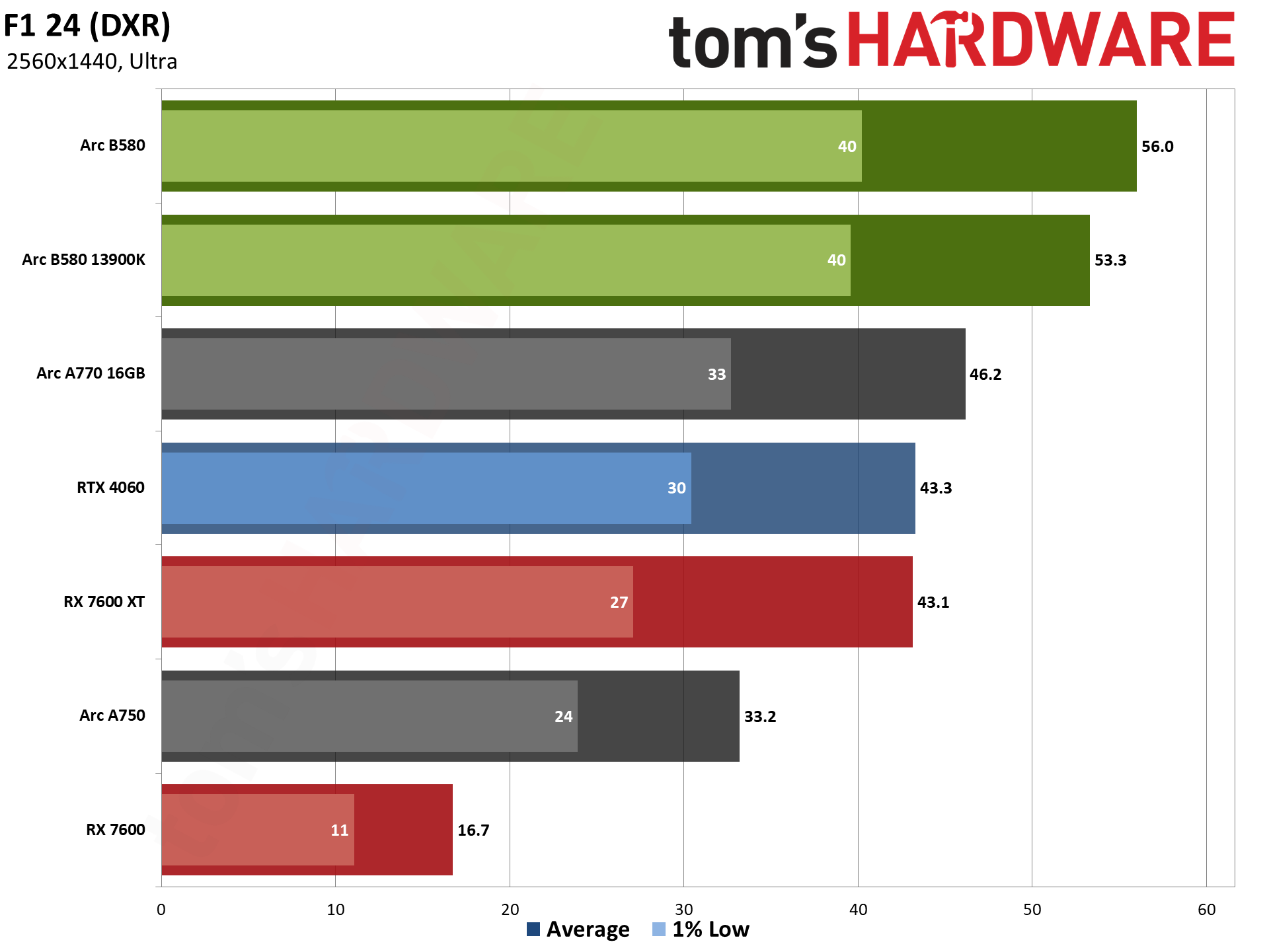
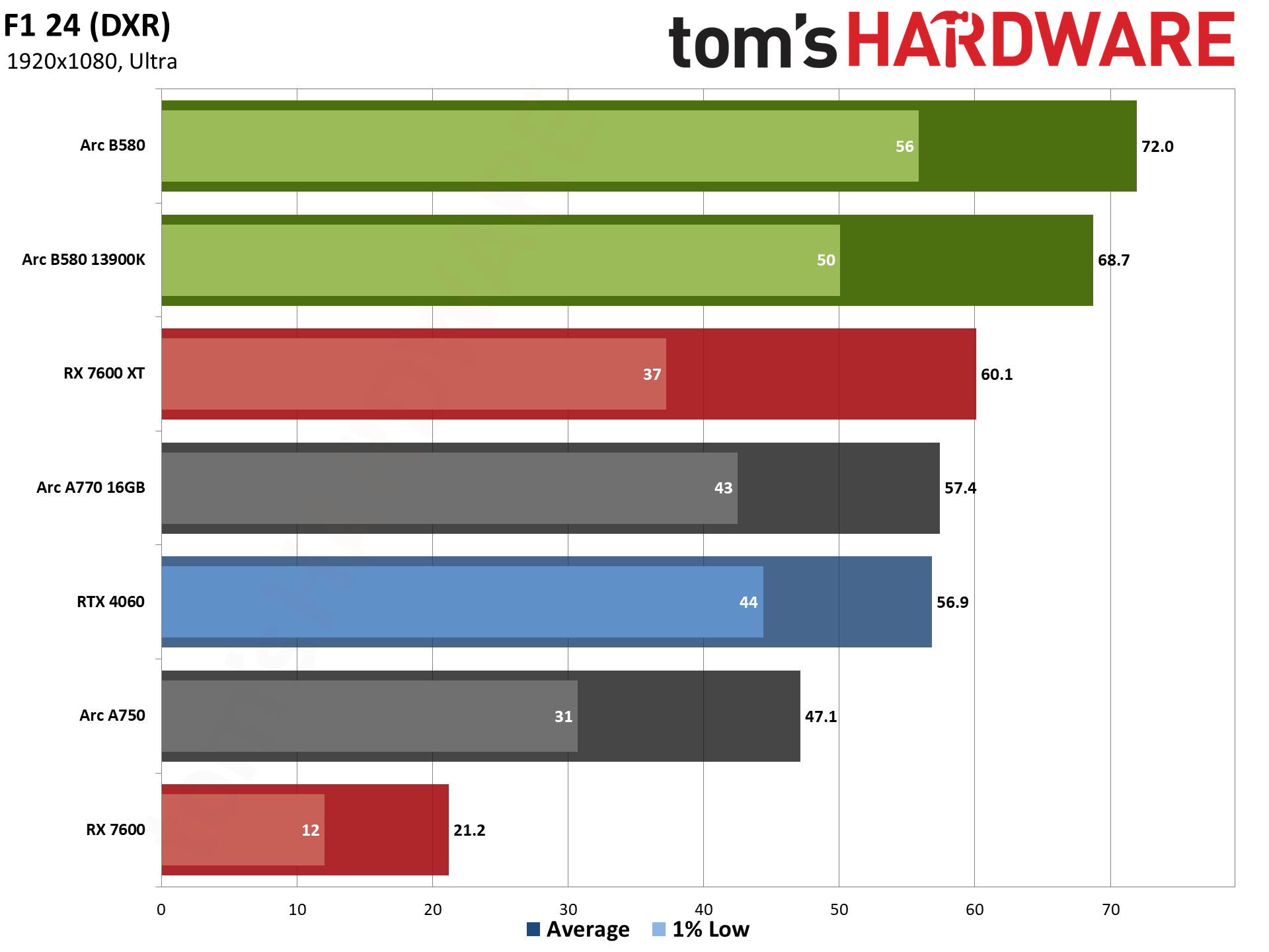
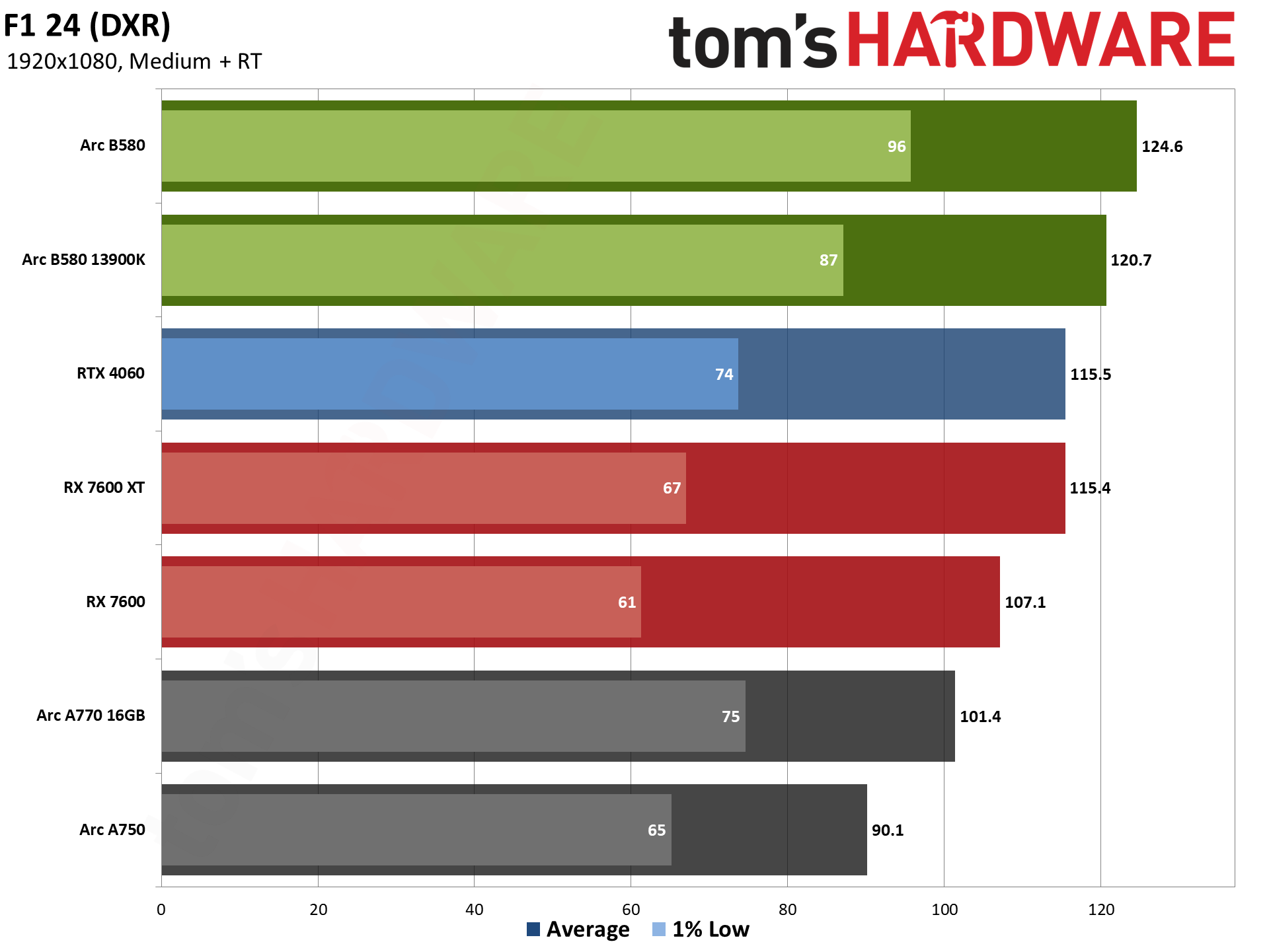
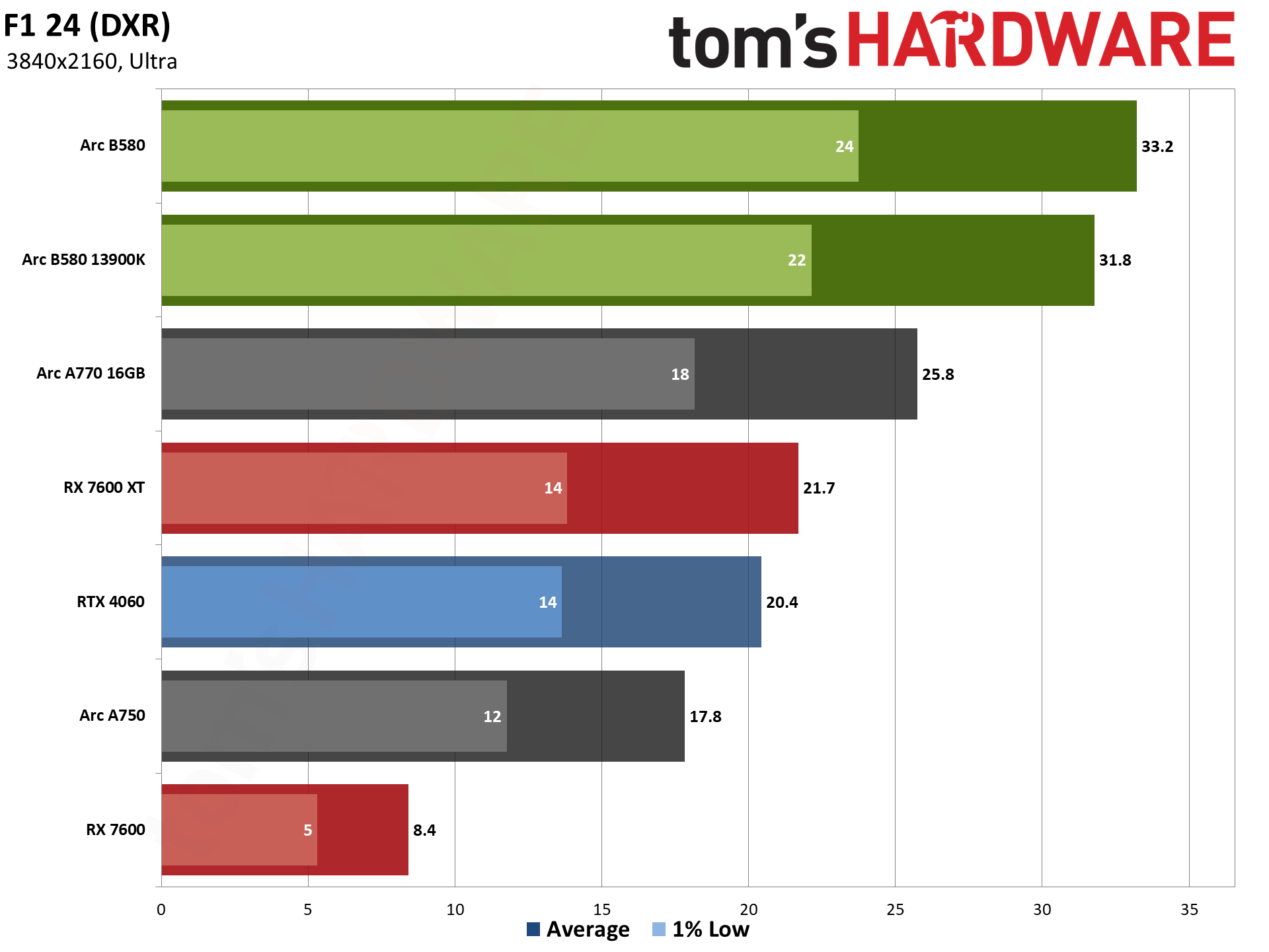
F1 24 enables several RT effects on the ultra preset but leaves them off on medium. But then 1080p medium runs at hundreds of frames per second, so we went ahead and turned all the RT effects on for our testing. F1 24 will also be the first game to get XeSS 2 support with XeSS-FG, though getting that working right now requires jumping through some extra hoops and performance isn't quite where it should be on Arc B580.
Intel actually released an updated preview driver that improved performance in F1 24, but also broke the XeSS-FG support, so it put out a second driver update that restored XeSS-FG but rolled back the minimum FPS fix. Given the seemingly beta nature of the XeSS-FG support, for now we're going to just stick to native rendering and hold off on a deeper dive into XeSS 2 until more games become available.
With the 6251 drivers that improved B580 performance (and especially minimum fps), the B580 ends up 38–86 percent ahead of the previous generation A750, and 23–29 percent ahead of the A770. RTX 4060 ends up looking a lot like the Arc A750. The B580 wins by 8, 27, 29, and 63 percent as we go up the resolution and quality scale.
AMD's 7600 again runs out of VRAM at ultra settings, so while the B580 is only 16% faster at 1080p medium, it's 235–295 percent faster with ultra settings. Compare that with the RX 7600 XT where the margins are 'only' 8, 20, 30, and 53 percent.
Get Tom's Hardware's best news and in-depth reviews, straight to your inbox.
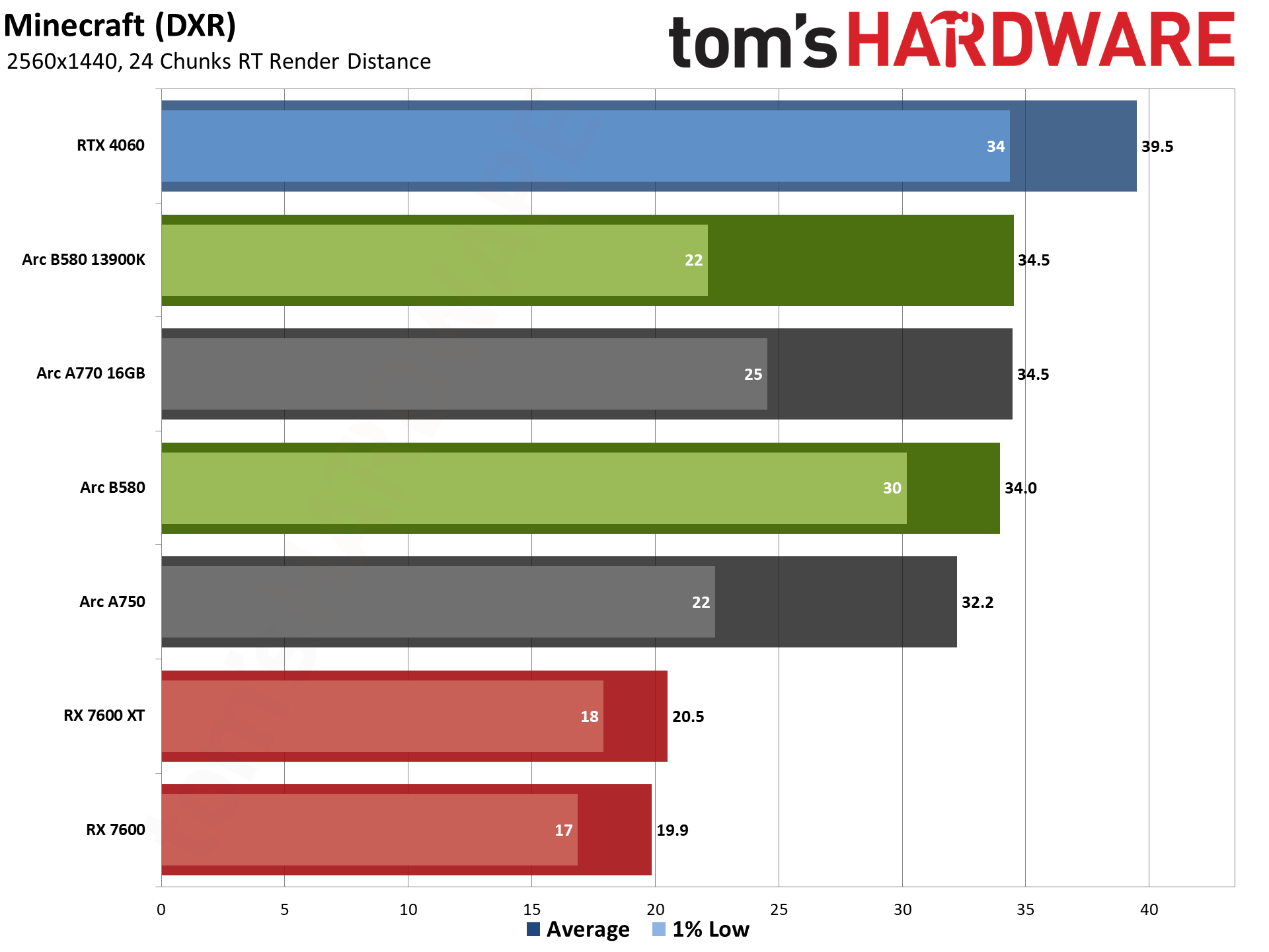
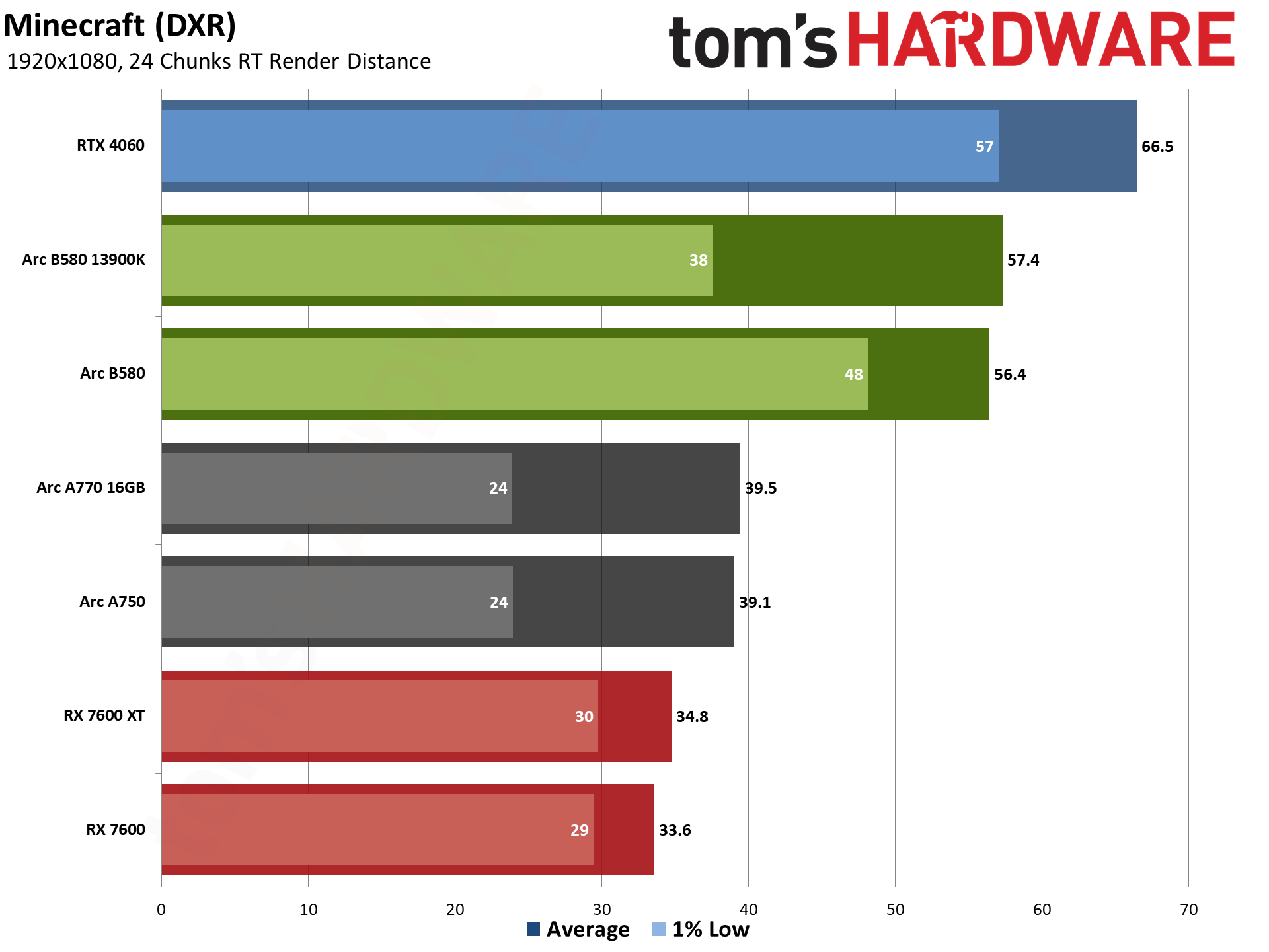
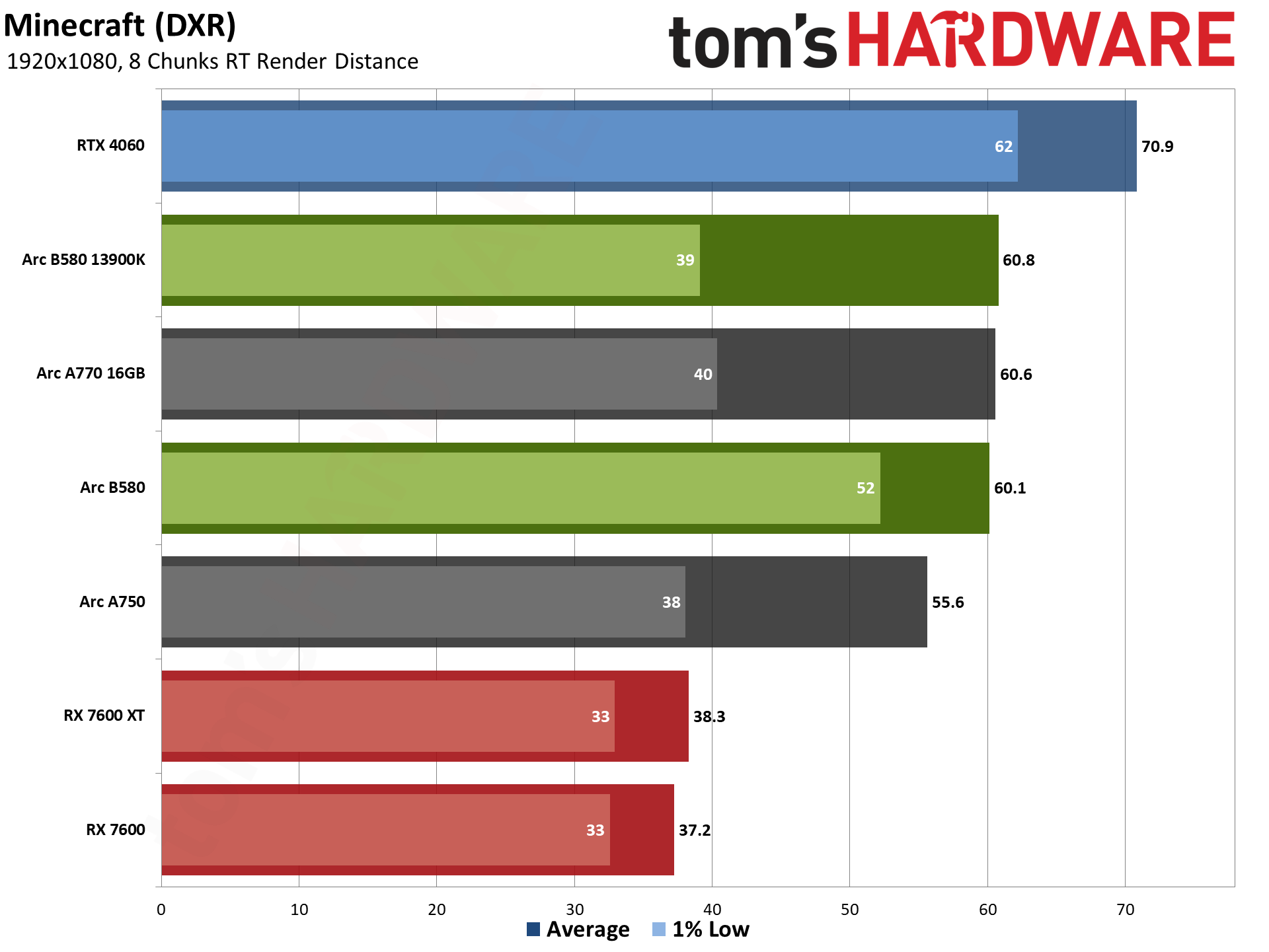
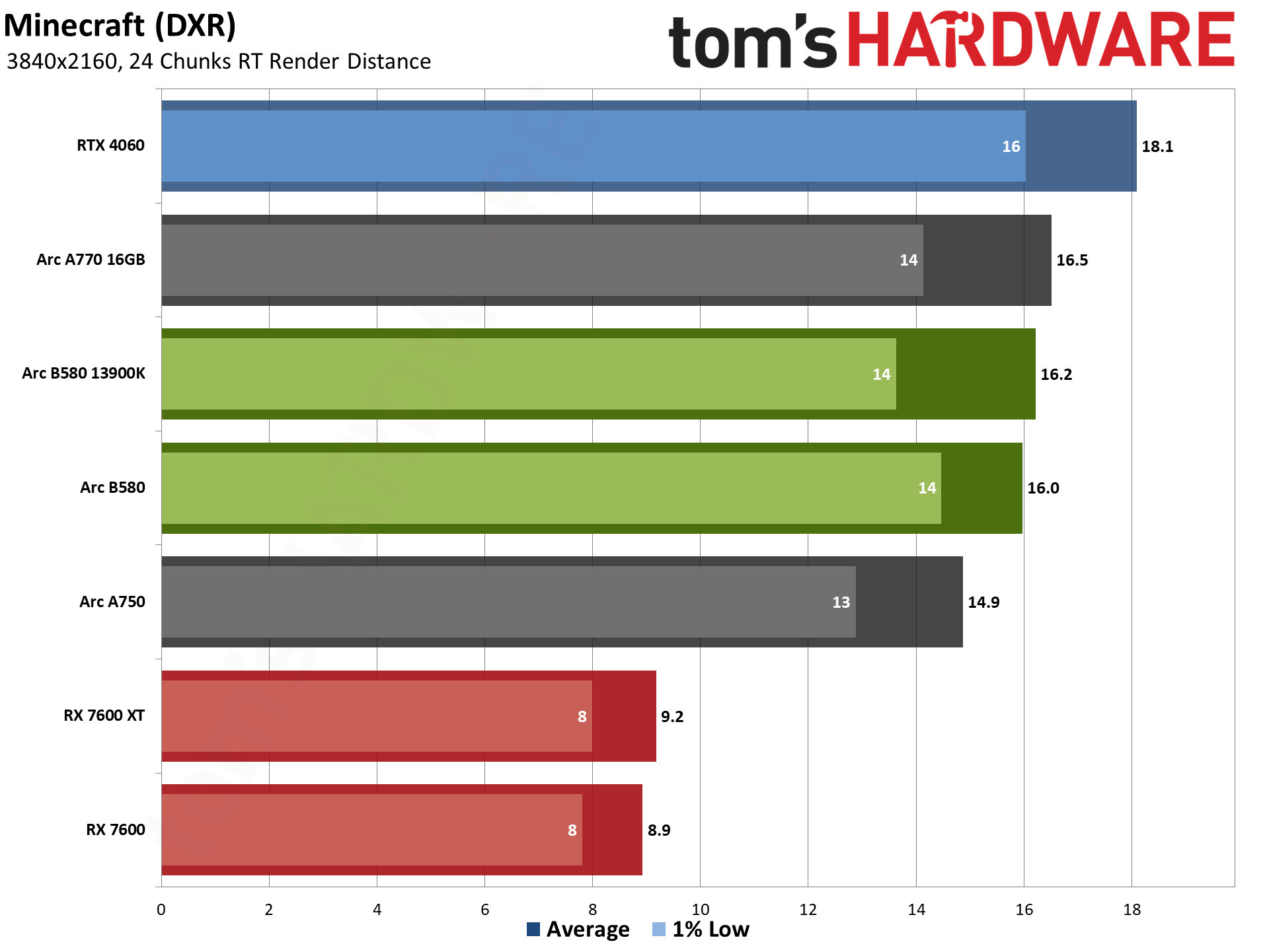
Minecraft doesn't normally push your GPU very hard, and you can totally play it on integrated graphics. But if you want to enable the full path tracing, it dramatically changes both the look of the game world and massively drops performance. Getting over 200 fps at 1080p without RT is pretty easy, but with RT enabled most GPUs will drop below 60 fps.
Starting with Nvidia's RTX 4060 this time, it gets the clean sweep for a change. That could be due to vendor-specific RT optimizations made by the game developers (Minecraft RTX was heavily promoted by Nvidia when it first came out and had lots of Nvidia engineering help), or maybe it's just proof that Nvidia's RT cores are still superior. The 4060 beats the B580 by 13–18 percent in Minecraft.
The A770 mostly matches (and slightly beats) the B580, except for at 1080p where the A-series GPUs seem to hit a CPU limit or something. That happened with both the A770 and A750, so while the B580 beats the A750 by just 5–8 percent at 1080p medium, 1440p ultra, and 4K ultra, it's 44% faster at 1080p ultra.
AMD's 7000-series budget GPUs struggle badly with the full RT used in Minecraft. B580 is 62–79 percent faster than the vanilla 7600, and 57–74 percent faster than the 7600 XT. VRAM capacity isn't a problem, so the only real advantage for the XT card in this case is slightly higher core clocks and power limits.
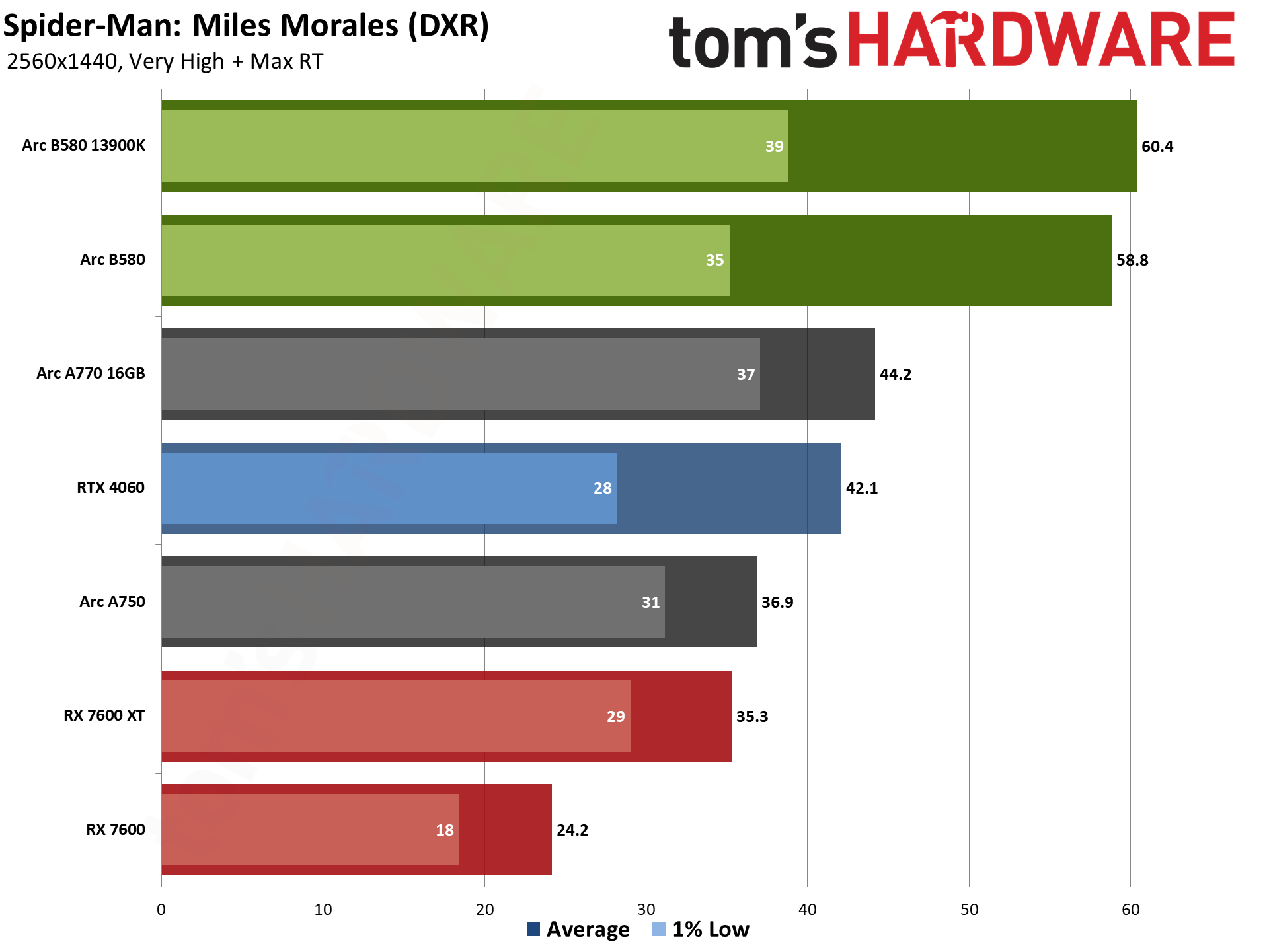
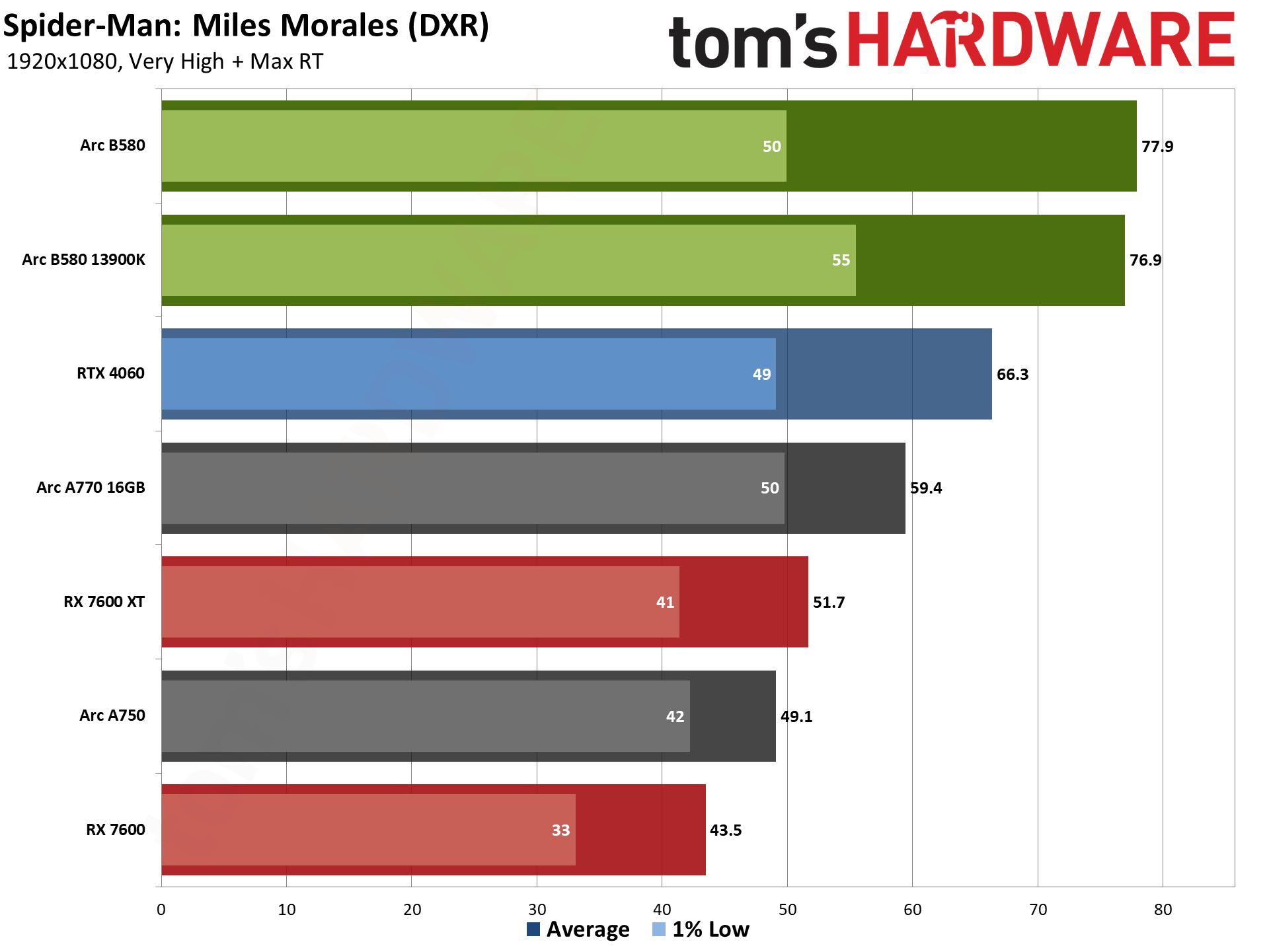
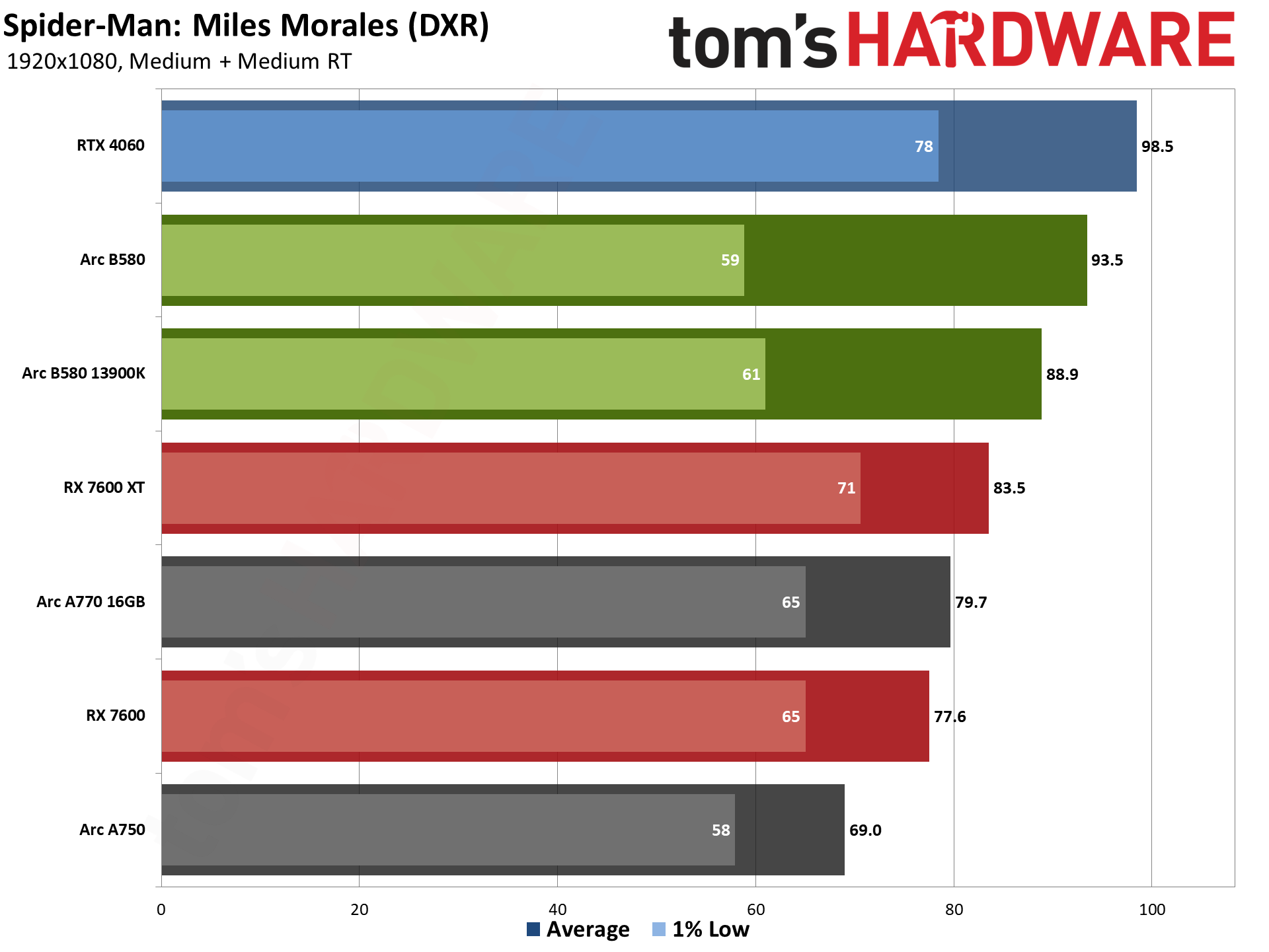
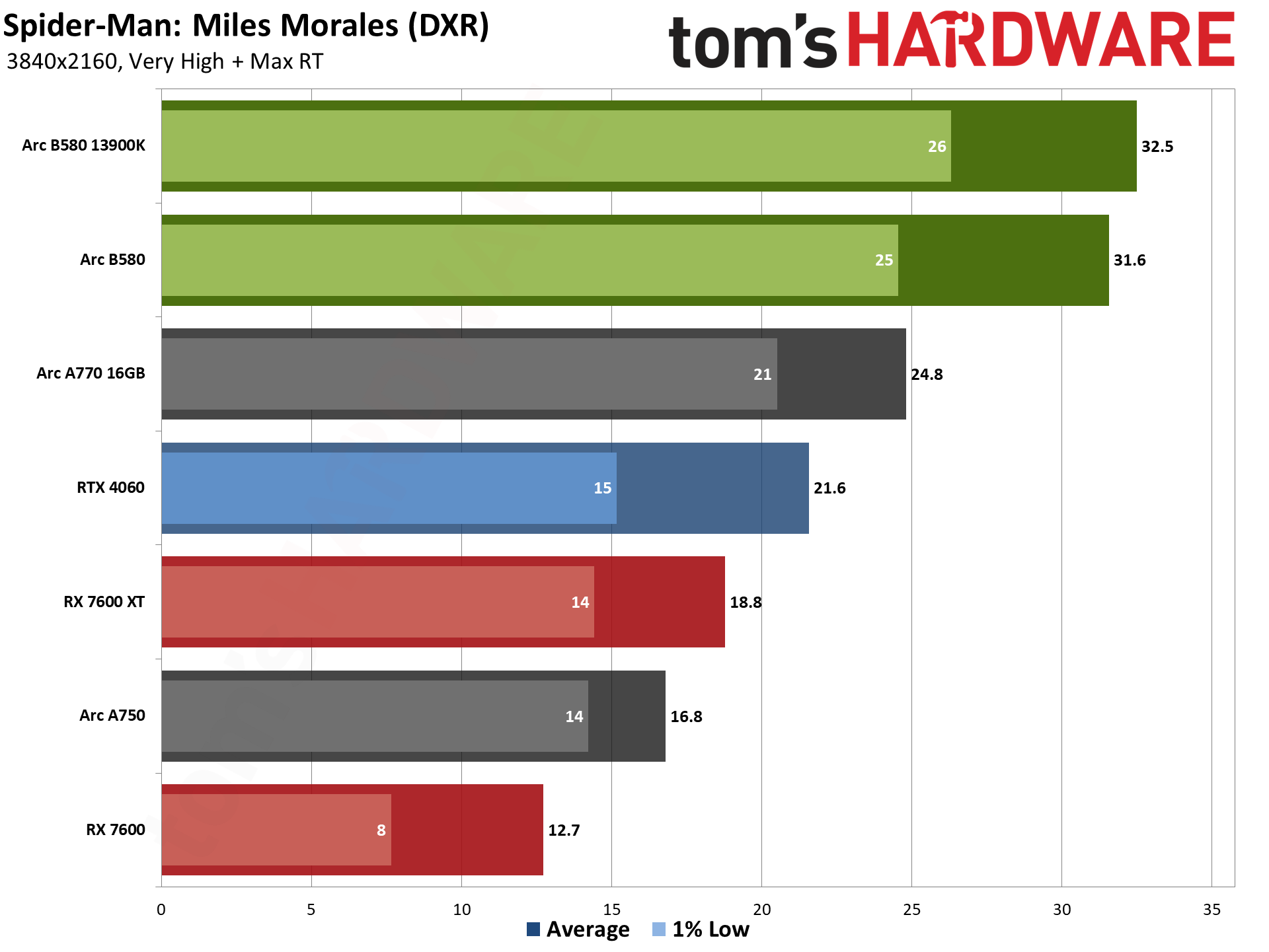
Last on our list of RT-enabled games, Spider-Man: Miles Morales doesn't look as nice with RT turned on as the previous Spider-Man: Remastered. The reflections are less obvious, and perhaps performance is better as a result. But beyond the RT effects, maxed out settings in Miles Morales definitely needs more than 8GB of VRAM.
Starting with Nvidia's RTX 4060 this time, it gets the win at 1080p 'medium' (medium preset but with RT turned on) but then falls well off the pace. B580 runs 18–46 percent faster with the maxed out very high preset plus max RT, with a 40–46 percent lead at 1440p and 4K.
The A770 doesn't have any VRAM limitations, but the superior RT hardware in Battlemage allows the B580 to lead by 17–33 percent. A750 on the other hand does have VRAM problems at higher settings, and B580 comes out 36, 59, 60, and 88 percent faster.
AMD's RX 7600 XT doesn't run out of VRAM, but it lacks the RT hardware muscle to keep pace. As a result, B580 runs 12% faster at our medium settings, and then gets a big jump to 51–69 percent faster at our ultra settings. And RX 7600 manages to be playable at 1080p, with B580 leading by 21% at medium quality but 79% at ultra settings. Then that balloons to a 143% and 148% lead at 1440p and 4K.
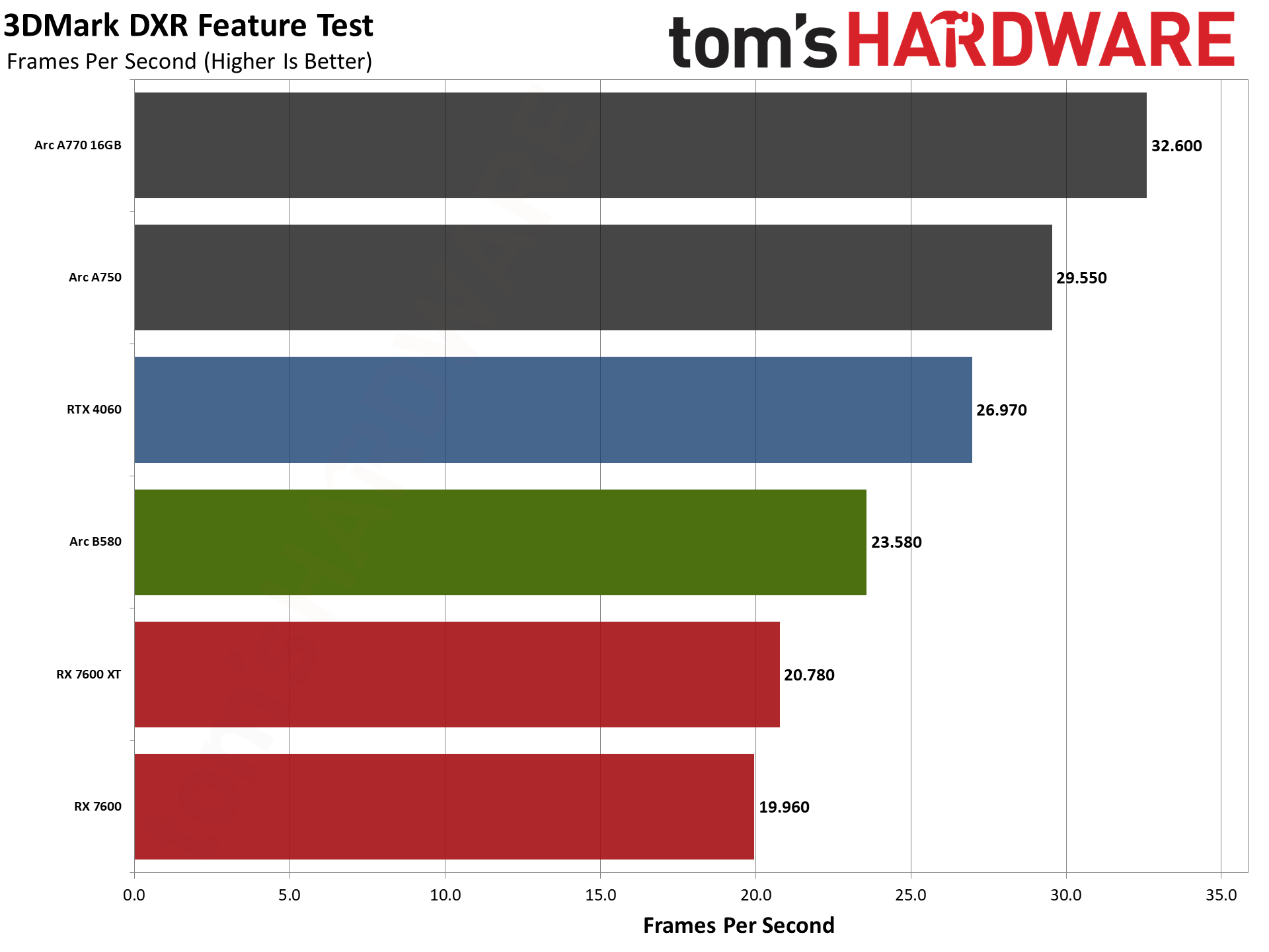
One final ray tracing benchmark we have is the 3DMark DXR Feature Test, where we report the average FPS rather than the calculated score. This is similar to full RT in a game, only done via a standalone benchmark and perhaps in a more vendor agnostic fashion. Or maybe not, but clearly the current Battlemage drivers aren't optimized for this particular workload.
The A770 claims the top spot at 33 fps, followed by the A750 with 30 fps. Nvidia's RTX 4060 comes in third at 27 fps, and then finally the B580 shows up at just under a "cinematic" 24 fps (I'm joking about it being cinematic, if that's not clear). AMD's GPUs bring up the rear on pure RT performance with just under 21 and 20 fps.
I may see about testing an actual game that has full RT as an option, at 720p, just to see if the standings change. I suspect they will, if the B580 drivers are better optimized for games than 3DMark's DXR feature test.
- MORE: Best Graphics Cards
- MORE: GPU Benchmarks and Hierarchy
- MORE: All Graphics Content
Current page: Intel Arc B580 Ray Tracing Gaming Performance
Prev Page Intel Arc B580 Rasterization Gaming Performance Next Page Intel Arc B580: Content Creation and AI Performance
Jarred Walton is a senior editor at Tom's Hardware focusing on everything GPU. He has been working as a tech journalist since 2004, writing for AnandTech, Maximum PC, and PC Gamer. From the first S3 Virge '3D decelerators' to today's GPUs, Jarred keeps up with all the latest graphics trends and is the one to ask about game performance.
-
Math Geek nicely done :)Reply
looks like a good value. i'm in the market for my next card but seems like waiting a little bit to see what AMD does next is not too bad of an idea. i hate waiting to see what the next best thing is but this close it seems like prudent advice.
side note: it does look like you forgot to replace the place holders on the power consumption paragraph.
"On average, the B580 used xxxW at 1080p medium, xxxW at 1080p ultra, xxxW at 1440p, and xxxW at 4K. As you'd expect, power use typically increases at higher settings and resolutions." -
Jagar123 I am happy to have competition in the market. I imagine next gen AMD and Nvidia cards will be stronger competitors but they might be priced poorly again. Price to performance is key here. We'll see in a month or so.Reply -
shady28 Great review, against relevant parts for this price class too :DReply
Given that Steam shows the 3 most popular GPUs are the 3060 discrete, 4060 laptop, and 4060 discrete, Intel now has a GPU that competes in the largest part of the segment - and leads it in both value and performance.
Granted AMD and Nvidia are about to release new GPUs, but let's also note that the 5060 / 8600 aren't likely to show up until late 2025 or early 2026 if they follow their normal pattern. -
palladin9479 Great review, I'm in the market for a SFF two slot low power card for a living room system. The APU can only do so much and I'm starting to hit walls with it lately so a lower power dGPU might be the only real answer.Reply -
Gururu I guess it will come down to an availability issue. I doubt we will see superior cards by AMD or nVidia in this price bracket by end of Q1 2025. We will certainly see lots of benchmarks blowing these early battlemage offerings in January, but nothing ready for purchase. Later battlemage offerings are in my best guess going to be in the $400 range, likely beating 7800 and 4070, but again probably not until mid-late Q1. If AMD and nVidia drop anything crushing a 4090 you can bet it will be in the $700+ range. Is it fair to say that something beating the B580 readily available in April for $250 is fair competition now? I don't know. Maybe not if a normal consumer can actually get B580 silicon before Christmas.Reply -
Eximo Reply
I would probably still lean towards an RTX 3050 6GB for that. B580 is still a little power hungry for the job.palladin9479 said:Great review, I'm in the market for a SFF two slot low power card for a living room system. The APU can only do so much and I'm starting to hit walls with it lately so a lower power dGPU might be the only real answer.
I use an A380, and that isn't ideal either, since it still needs an 8-pin (at least that model). Though supposedly still only a 75W GPU. -
DS426 Great review, Jarred! The elaboration on your thinking and updating of your test bench's hardware and software is appreciated.Reply
It'll be some time before AMD and NVIDIA (green wants it written this way, by the way: http://http.download.nvidia.com/image_kit/LG_NVCorpBadge.pdf ... was curious as I noticed they have it written that way on their website) have new budget GPU's in this price class, so I myself wouldn't really recommend that a prospective owner waits. Of course, a lot of it also depends on if building new or upgrading (and upgrading from what). There's a huge user base at this price point, so I do imagine that Intel will get some market penetration for end users, not just prebuilds. This, particularly since day 1 drivers are already fairly stable overall and Intel now has the value leader at this price point; Intel didn't mess up this launch, whereas botched launches can tarnish audience sentiment of the product for months and years, if not permanently. -
King_V Definitely liking what I see here. And, glad to know that Intel is taking this very seriously. They're clearly not messing around.Reply -
rluker5 Transistor density pretty close to AMD.Reply
Transistor density of 7600XT is 65.2 M/mm2 and B580 is 72.1 M/mm2 per Techpowerup. Sure B580 is on 5nm while 7600XT is on 6nm but that isn't that big a difference. Definitely moving in the right direction. And more importantly performance per mm2 is much closer to AMD. And performance per watt.
Catching up really fast. -
caseym54 Probably flogging a dead horse here, but a 6-column table with 5 columns visible and a slider is truly lame.Reply
